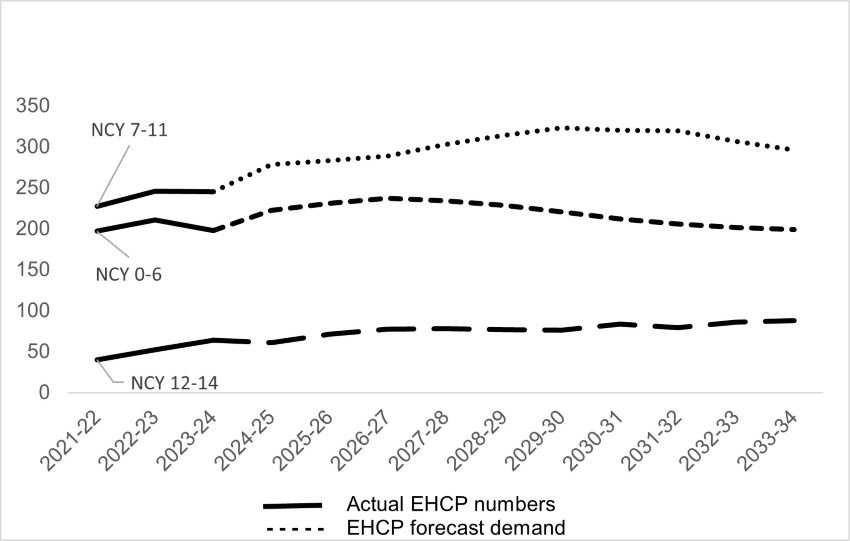Introduction
This data provides demographic information and highlights the likely demand for school places over a 10 year projection period. It has been divided into the 11 districts and boroughs and includes information on:
- the current pattern of school provision across the county
- projections of future pupil numbers for mainstream and specialist schools
Elmbridge
The borough of Elmbridge is located in north east Surrey.
From a peak in 2010, births in Elmbridge continue to fall, reaching a low in 2023. This is the lowest birth rate in the borough since the start of the millennium.
| Year | Number of births |
|---|---|
| 2010 | 1,890 |
| 2011 | 1,879 |
| 2012 | 1,826 |
| 2013 | 1,848 |
| 2014 | 1,785 |
| 2015 | 1,755 |
| 2016 | 1,646 |
| 2017 | 1,659 |
| 2018 | 1,526 |
| 2019 | 1,478 |
| 2020 | 1,496 |
| 2021 | 1,474 |
| 2022 | 1,386 |
| 2023 | 1,287 |
- At their highest births in the borough reached 1,890 in 2010.
- Since the peak in 2010, births have decreased by 31%, reaching a low of 1,287 in 2023. This is the lowest birth rate in the borough since 2002.
As of academic year 2024 to 2025 Elmbridge has:
- 11 school based nurseries
- 6 infant schools
- 4 junior schools
- 18 primary schools
- 1 all-through school (ages 4 to 18)
- 5 secondary schools
- 2 specialist schools
- 7 specialist units (in mainstream schools)
- 4 sixth forms
- 2 colleges
- 1 pupil referral unit
As of April 2025, the above schools are comprised of the following school types:
| School Type | % of schools |
|---|---|
| Academy | 41% |
| Community | 19% |
| Foundation | 16% |
| Free | 8% |
| Voluntary Aided | 11% |
| Voluntary Controlled | 5% |
As of April 2025, schools in Elmbridge have the following Ofsted ratings:
| Ofsted rating | Number of schools |
|---|---|
| Outstanding | 6 |
| Good | 29 |
| Requires Improvement | 0 |
| Inadequate | 0 |
| Schools which currently do not have a current Ofsted report | 2 |
Elmbridge is made up of six individual primary planning areas. Each primary phase school is allocated to one of these planning areas for the purpose of planning school places. Details of the planning areas and published admission number (PAN) are outlined in the table below:
| Primary planning areas | Number of schools | Year Reception PAN | Year 3 PAN |
|---|---|---|---|
| Cobham and Oxshott | 4 | 138 | 6 |
| Esher and Weston Green | 2 | 120 | 0 |
| Moleseys | 5 | 270 | 90 |
| The Dittons, Claygate and Hinchley Wood | 7 | 360 | 150 |
| Walton and Hersham | 6 | 450 | 0 |
| Weybridge | 5 | 270 | 180 |
Elmbridge is a single secondary planning area, this means that demand for secondary places is estimated across the whole borough.
| Secondary planning areas | Number of schools | Year 7 PAN |
|---|---|---|
| Elmbridge | 6 | 1,166 |
Specialist school places are planned at a borough and quadrant level because it involves a significantly smaller number of pupils and because there is also a wider range of educational provision available.
For the academic year 2024 to 2025 there are 319 school places in specialist provision across the borough, categorised as follows:
| Need type | Type of provision | Number of places |
|---|---|---|
| Severe Learning Difficulties | Specialist school | 88 |
| Autism, Communication and Interaction Needs | Specialist school | 77 |
| Autism, Communication and Interaction Needs | Specialist unit | 132 |
| Speech, Language and Communication Needs | Specialist unit | 6 |
| Moderate Learning Difficulties | Specialist unit | 16 |
Mainstream primary provision - 2024 to 2025 academic year
| Primary (National Curriculum Year (NCY) Reception to 6) school places | Primary (NCY Reception to 6) pupils on roll | Boys | Girls |
|---|---|---|---|
| 11,064 | 10,288 | 5,231 | 5,057 |
Mainstream secondary provision - 2024 to 2025 academic year
| Secondary (NCY 7 to 11) school places | Secondary (NCY 7 to 11) pupils on roll | Boys | Girls |
|---|---|---|---|
| 5,656 | 5,502 | 2,778 | 2,724 |
(Please note number of places available are inclusive of schools who have capped their published admissions number in years 1-6 for primary and years 8-11 for secondary. Figures also include any bulge class provision across years Reception to 11 and any schools who may have more pupils on roll than their published admissions number)
Specialist provision - 2024 to 2025 academic year
| Specialist (NCY Reception to 14) school places | Specialist (NCY Reception to 14) pupils on roll | Boys | Girls |
|---|---|---|---|
| 289 | 271 | 192 | 79 |
As of academic year 2023 to 2024 there were around 1,350 pupils in years Reception to 14 with an Education Health Care Plan (EHCP) residing in Elmbridge. Of these pupils approximately 39% require a specialist school or unit place. The most prevalent of all need types for both primary and secondary phase pupils in Elmbridge is Autism Spectrum Disorder (ASD).
In January 2025, there were 162 children with an EHCP attending a specialist school in Elmbridge. They lived in the following areas:
| Location | Number of pupils |
|---|---|
| Elmbridge | 49 |
| Other borough in North East Surrey (Spelthorne or Epsom and Ewell) | 43 |
| Elsewhere in Surrey | 68 |
| Out of county | 2 |
In January 2025, there were 109 children with an EHCP attending a specialist unit attached to a mainstream school in Elmbridge. They lived in the following areas:
| Location | Number of pupils |
|---|---|
| Elmbridge | 70 |
| Other borough in North East Surrey (Spelthorne or Epsom and Ewell) | 26 |
| Elsewhere in Surrey | 13 |
| Out of county | 0 |
Demand for reception places in Elmbridge reached around 1,565 pupils in academic year 2020 to 2021. In 2023 to 2024 there were approximately 1,430 pupils on roll. Projections for reception places in Elmbridge are expected to fall further to around 1,175 pupils by 2033 to 2034.
Demand for reception places in Elmbridge
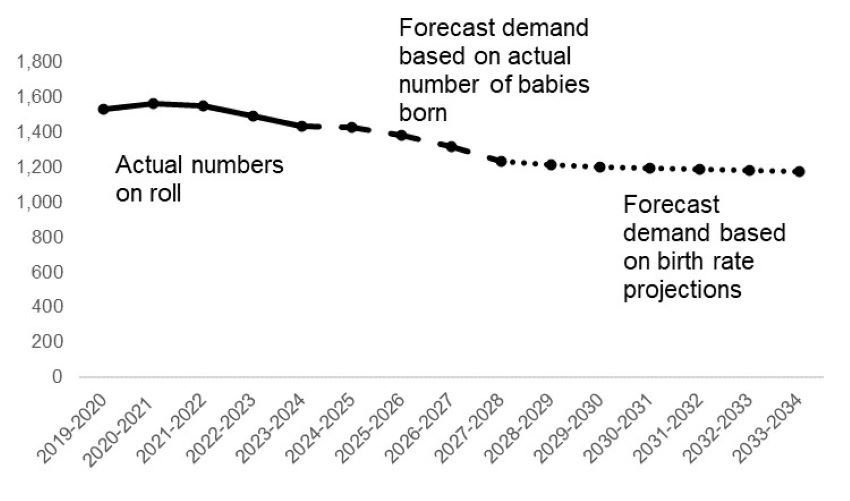
In academic year 2019 to 2020 there were around 1,005 pupils in year 7, demand has increased year on year since then reaching nearly 1,200 pupils in 2022 to 2023. This is reflective of the higher birth rates. Demand for year 7 places is projected to peak at around 1,210 pupils in 2025 to 2026 before declining to just 1,000 pupils by the end of the planning period. The opening of Heathside Walton-on-Thames in September 2022 will continue to impact on existing pupil movement trends in the area in the short term.
Demand for year 7 places in Elmbridge
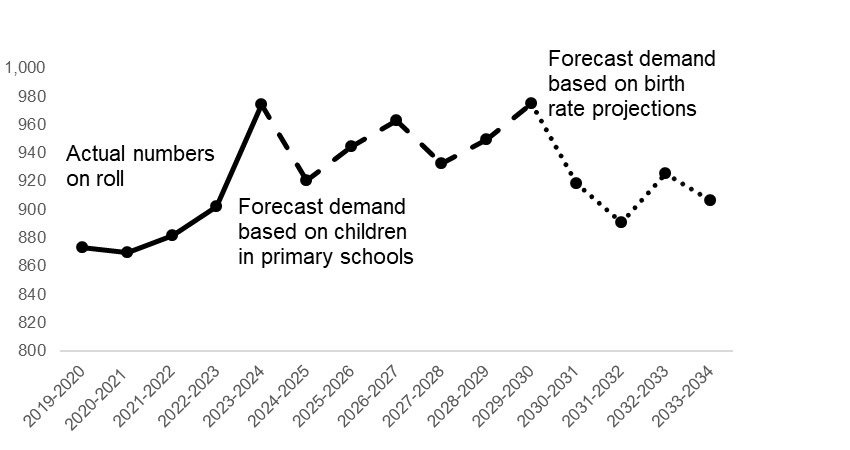
The number of children and young people aged 0 to 25 years with an EHCP residing in Elmbridge has increased by around 16% since January 2022.
EHCP demand for primary phase pupils is expected to increase year on year peaking at around 535 pupils in academic year 2027 to 2028. Demand is then projected to decrease annually reaching around 435 pupils by 2033 to 2034.
For secondary phase pupils, demand is expected to peak in academic year 2026 to 2027 at around 715 pupils. This is in line with the high birth rate cohorts moving through the secondary sector. EHCP demand is then expected to decrease year on year reaching around 580 pupils by 2033 to 2034.
For post-16 phase pupils, demand is projected to increase from around 190 pupils in academic year 2021 to 2022, peaking in academic year 2029 to 2030 at around 495 pupils.
EHCP demand in Elmbridge
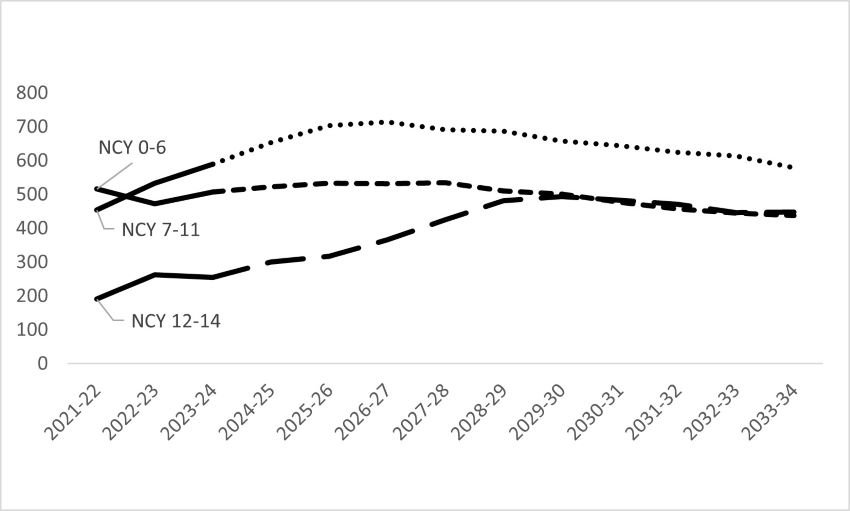
In 2023 to 2024 academic year, there were 525 children and young people with an EHCP, residing in Elmbridge and attending a specialist provision (either maintained or non-maintained/independent) in school years Reception to 14.
For primary phase pupils living in Elmbridge who require a specialist school or centre, demand is expected to plateau at around 195 pupils until academic year 2028 to 2029, demand is then expected to decrease annually reaching around 160 pupils by 2033 to 2034.
Secondary phase demand is projected to increase year on year peaking in academic year 2026 to 2027 at approximately 375 pupils. Demand is then expected to decrease reaching around 315 pupils by 2033 to 2034.
For post-16 phase pupils, demand is forecasted to increase from around 60 pupils in academic year 2023 to 2024 at circa 110 pupils in 2029 to 2030. Demand is then expected to decrease to around 95 pupils by 2033 to 2034.
Demand for pupils living in Elmbridge who will require a specialist school or centre place
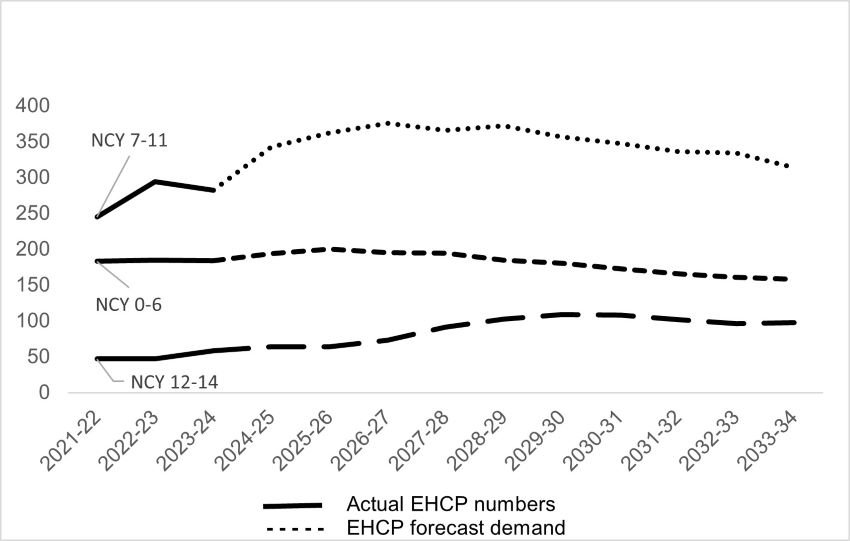
Epsom and Ewell
The borough of Epsom and Ewell is located in North East Surrey.
From a peak in 2015, births in Epsom and Ewell continue to fall, reaching a low in 2023. This is the lowest birth rate in the borough since the start of the millennium.
| Year | Number of births |
|---|---|
| 2010 | 918 |
| 2011 | 930 |
| 2012 | 952 |
| 2013 | 909 |
| 2014 | 920 |
| 2015 | 958 |
| 2016 | 950 |
| 2017 | 943 |
| 2018 | 904 |
| 2019 | 824 |
| 2020 | 864 |
| 2021 | 813 |
| 2022 | 814 |
| 2023 | 744 |
- At their highest births in the borough reached 958 in 2015.
- Since the peak in 2015, births have decreased by 22%, reaching a low of 744 in 2023.
As of academic year 2024 to 2025 Epsom and Ewell has:
- 12 school based nurseries
- 3 infant schools
- 3 junior schools
- 13 primary schools
- 4 secondary schools
- 1 specialist school
- 6 specialist units (in mainstream schools)
- 4 sixth forms
- 1 college
As of April 2025, the above schools are comprised of the following school types:
| School type | % of schools |
|---|---|
| Academy | 75% |
| Community | 12% |
| Foundation | 0% |
| Free | 0% |
| Voluntary Aided | 13% |
| Voluntary Controlled | 0% |
As of April 2025, schools in Epsom and Ewell have the following Ofsted ratings:
| Ofsted rating | Number of schools |
|---|---|
| Outstanding | 7 |
| Good | 16 |
| Requires Improvement | 0 |
| Inadequate | 1 |
| Schools which currently do not have a current Ofsted report | 0 |
Epsom and Ewell is made up of four individual primary planning areas. Each primary phase school is allocated to one of these planning areas for the purpose of planning school places.
| Primary planning areas | Number of schools | Year Reception PAN | Year 3 PAN |
|---|---|---|---|
| Ewell | 6 | 360 | 6 |
| North West Epsom | 3 | 210 | 0 |
| South Epsom and Langley Vale | 6 | 240 | 158 |
| Stoneleigh and Worcester Park | 4 | 210 | 90 |
Epsom and Ewell is a single secondary planning area, this means that demand for secondary places is estimated across the whole borough. For place planning purposes, The Beacon School located in Banstead is included in the Epsom and Ewell secondary planning area.
| Secondary planning areas | Number of schools | Year 7 PAN |
|---|---|---|
| Epsom and Ewell | 5 | 1,200 |
Specialist school places are planned at a borough and quadrant level because it involves a significantly smaller number of pupils and because there is also a wider range of educational provision available.
For the academic year 2024 to 2025 there are 223 school places in specialist provision across the borough, categorised as follows:
| Need type | Type of provision | Number of places |
|---|---|---|
| Complex Autism, Communication and Interaction Needs | Specialist school | 141 |
| Moderate Learning Difficulty | Specialist school satellite unit | 12 |
| Autism, Communication and Interaction Needs | Specialist unit | 29 |
| Speech, Language and Communication Needs | Specialist unit | 15 |
| Hearing Impairment Needs | Specialist unit | 26 |
Mainstream primary provision - 2024 to 2025 academic year
| Primary (NCY Reception to 6) school places | Primary (NCY Reception to 6) pupils on roll | Boys | Girls |
|---|---|---|---|
| 7,196 | 6,831 | 3,486 | 3,345 |
Mainstream secondary provision - 2024 to 2025 academic year
| Secondary (NCY 7 to 11) school places | Secondary (NCY 7 to 11) pupils on roll | Boys | Girls |
|---|---|---|---|
| 4,590 | 4,585 | 2,269 | 2,316 |
(Please note number of places available are inclusive of schools who have capped their published admissions number in years 1-6 for primary and years 8-11 for secondary. Figures also include any bulge class provision across years Reception to 11 and any schools who may have more pupils on roll than their published admissions number)
Specialist provision - 2024 to 2025 academic year
| Specialist (NCY Reception to 14) school places | Specialist (NCY Reception to 14) pupils on roll | Boys | Girls |
|---|---|---|---|
| 223 | 213 | 175 | 38 |
As of academic year 2023 to 2024 there were around 800 pupils in years Reception to 14 with an EHCP residing in Epsom and Ewell. Of these pupils approximately 41% require a specialist school or unit place. The most prevalent of all need types for primary phase pupils in Epsom and Ewell is Speech, Language and Communication Needs (SLCN) whilst for secondary phase pupils it is ASD.
In January 2025, there were 150 students with an EHCP attending specialist schools in Epsom and Ewell. They lived in the following areas:
| Location | Number of pupils |
|---|---|
| Epsom and Ewell | 46 |
| Other borough in North East Surrey (Elmbridge or Spelthorne) | 51 |
| Elsewhere in Surrey | 46 |
| Out of county | 7 |
In January 2025, there were 63 children with an EHCP attending a specialist unit attached to a mainstream school in Epsom and Ewell. They lived in the following areas:
| Location | Number of pupils |
|---|---|
| Epsom and Ewell | 33 |
| Other borough in North East Surrey (Elmbridge or Spelthorne) | 16 |
| Elsewhere in Surrey | 8 |
| Out of county | 6 |
Demand for reception places in Epsom and Ewell peaked at 1,015 pupils in academic year 2019 to 2020. In 2023 to 2024 there were approximately 930 pupils on roll. Projections are expected to fall below 900 pupils in 2024 to 2025 in line with the declining birth rate. From 2027 to 2028 onwards, demand is expected to plateau at around 850 pupils before a further decline at the end of the planning period.
Demand for reception places in Epsom and Ewell
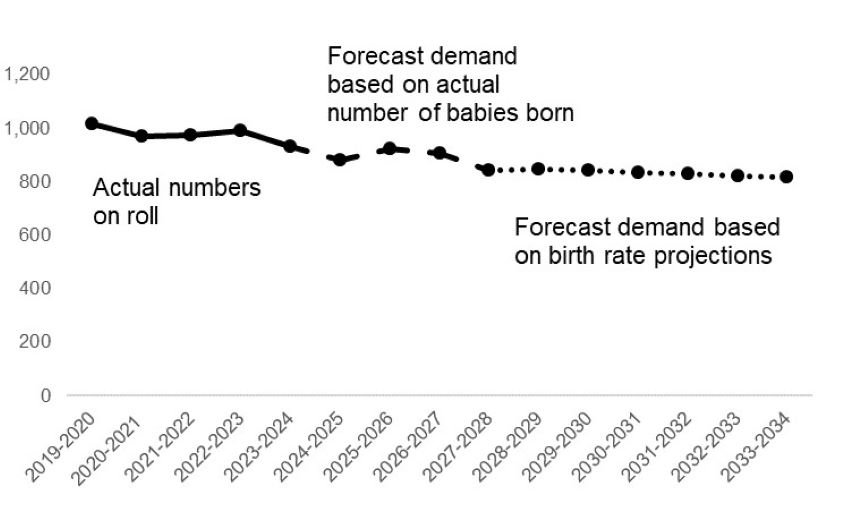
In academic year 2020 to 2021 there were 870 pupils in year 7 in Epsom and Ewell. Demand has increased year on year since and reached around 970 pupils in 2023 to 2024. Year 7 demand in Epsom and Ewell is expected to fluctuate for the rest of the planning period, peaking in 2029 to 2030 at approximately 975 pupils before dipping to around 900 pupils by the end of the planning period.
Demand for year 7 places in Epsom and Ewell
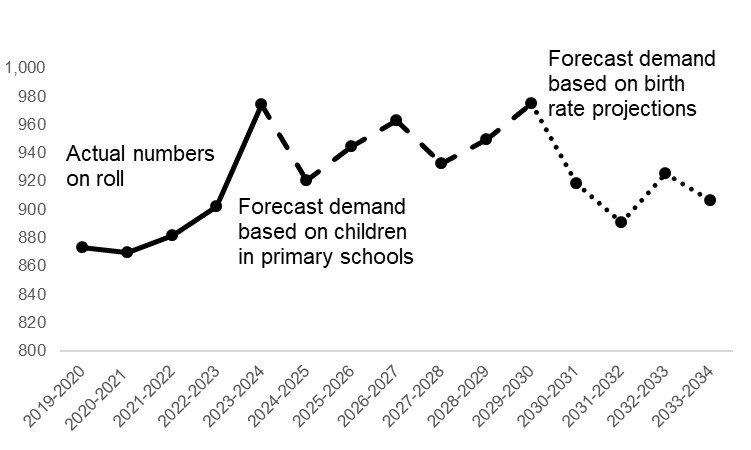
The number of children and young people aged 0 to 25 years with an EHCP residing in Epsom and Ewell has increased by around 19% since January 2022.
EHCP demand for primary phase pupils is projected to peak at around 375 pupils in academic year 2029 to 2030. Demand is then expected to plateau at around 355 pupils until the end of the planning period in 2033 to 2034.
For secondary phase pupils, demand is expected to increase year on year peaking at around 405 pupils in academic year 2027 to 2028. Demand is then projected to decrease throughout the planning period, reaching around 375 pupils by 2033 to 2034.
For post-16 phase pupils, demand is projected to steadily increase year on year, peaking in academic year 2030 to 2031 at around 275 pupils.
EHCP demand in Epsom and Ewell
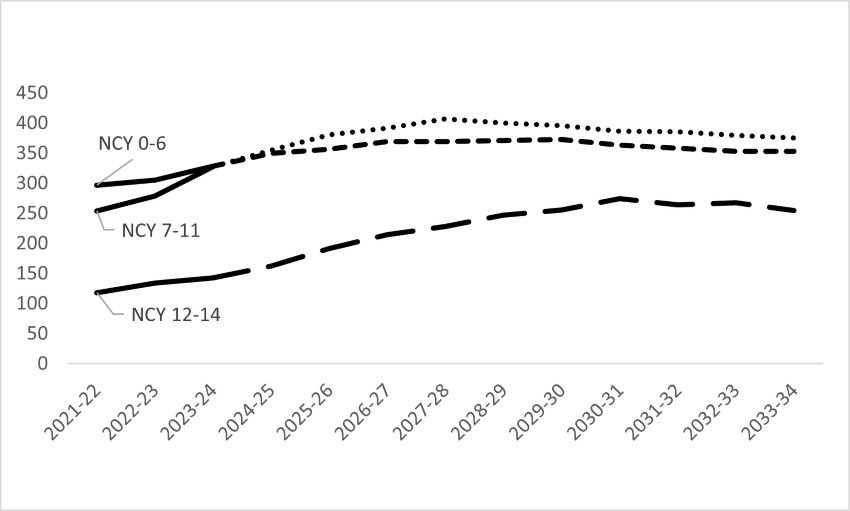
In 2023 to 2024 academic year, there were around 325 children and young people with an EHCP, residing in Epsom and Ewell and attending a specialist provision (either maintained or non-maintained/independent) in school years Reception to 14.
For primary phase pupils living in Epsom and Ewell who require a specialist school or specialist centre place, demand is expected to peak at around 160 pupils in academic year 2029 to 2030. Demand is then projected to plateau until the end of the planning period.
Secondary phase demand is projected to increase year on year until academic year 2028 to 2029 reaching around 190 pupils. Demand is then expected to plateau throughout the rest of the planning period.
For post-16 phase pupils, demand is forecasted to increase from around 30 pupils in academic year 2023 to 2024 at circa 60 pupils in 2030 to 2031. Demand is then expected to decrease through the rest of the planning period.
Demand for pupils living in Epsom and Ewell who will require a specialist school or centre place
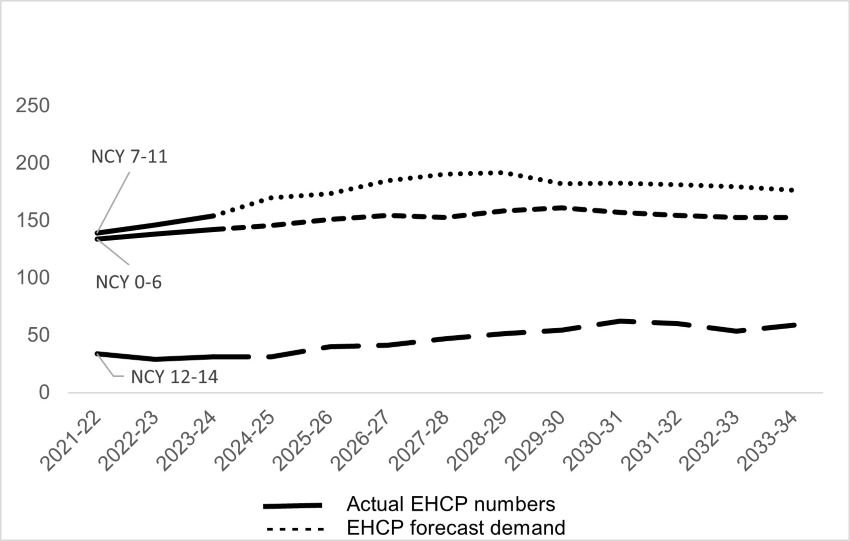
Guildford
The borough of Guildford is located in South West Surrey.
From a peak in 2012, births in Guildford have fluctuated year on year since.
| Year | Number of births |
|---|---|
| 2010 | 1,578 |
| 2011 | 1,667 |
| 2012 | 1,677 |
| 2013 | 1,535 |
| 2014 | 1,542 |
| 2015 | 1,513 |
| 2016 | 1,533 |
| 2017 | 1,393 |
| 2018 | 1,378 |
| 2019 | 1,264 |
| 2020 | 1,219 |
| 2021 | 1,370 |
| 2022 | 1,305 |
| 2023 | 1,319 |
- At their highest births in the borough reached 1,677 in 2012
- Since the peak in 2012, births have decreased by 27%, reaching a low of 1,219 in 2020. This is the lowest birth rate in the district in two decades.
As of academic year 2024 to 2025 Guildford has:
- 9 school based nurseries
- 1 maintained nursery
- 14 infant schools
- 6 junior schools
- 17 primary schools
- 7 secondary schools
- 3 specialist schools
- 5 specialist units (in mainstream schools)
- 5 sixth forms
- 1 college
- 2 pupil referral units
As of April 2025, the above schools are comprised of the following school types:
| School Type | % of schools |
|---|---|
| Academy | 58% |
| Community | 18% |
| Foundation | 2% |
| Free | 2% |
| Voluntary Aided | 14% |
| Voluntary Controlled | 6% |
As of April 2025, schools in Guildford have the following Ofsted ratings:
| Ofsted rating | Number of schools |
|---|---|
| Outstanding | 11 |
| Good | 36 |
| Requires Improvement | 2 |
| Inadequate | 1 |
| Schools which currently do not have a current Ofsted report | 0 |
Guildford is made up of seven individual primary planning areas. Each primary phase school is allocated to one of these planning areas for the purpose of planning school places. For place planning purposes, Bramley Church of England (CofE) Infant School and Wonersh and Shamley Green CofE Primary School which are geographically located in Waverley are included in the Tillingbourne Valley, Guildford primary planning area.
| Primary planning areas | Number of schools | Year Reception PAN | Year 3 PAN |
|---|---|---|---|
| Ash and Tongham | 7 | 240 | 68 |
| East Guildford | 6 | 285 | 62 |
| Horsleys and Effingham | 2 | 90 | 0 |
| North Guildford | 3 | 120 | 90 |
| South Guildford | 6 | 180 | 186 |
| Tillingbourne Valley | 7 | 162 | 90 |
| West Guildford | 4 | 237 | 30 |
Guildford borough is geographically large, and secondary schools in its area are considered as part of three different planning areas, two of which (Farnham and Ash and Leatherhead) overlap borough boundaries.
| Secondary planning areas | Number of schools | Year 7 PAN |
|---|---|---|
| Guildford Town | 5 | 966 |
Specialist school places are planned at a borough and quadrant level because it involves a significantly smaller number of pupils and because there is also a wider range of educational provision available.
For the academic year 2024 to 2025 there are 467 school places in specialist provision across the borough, categorised as follows:
| Need type | Type of provision | Number of places |
|---|---|---|
| Complex Autism, Communication and Interaction Needs Severe Learning Difficulty | Specialist school | 160 |
| Moderate Learning Difficulty | Specialist school | 130 |
| Social, Emotional and Mental Health Needs | Specialist school | 61 |
| Complex Autism, Communication and Interaction Needs | Specialist school satellite site | 36 |
| Speech, Language and Communication Needs | Specialist unit | 28 |
| Autism, Communication and Interaction Needs | Specialist unit | 23 |
| Hearing Impairment Needs | Specialist unit | 15 |
| Moderate Learning Difficulty | Specialist unit | 14 |
Mainstream primary provision - 2024 to 2025 academic year
| Primary (NCY Reception to 6) school places | Primary (NCY Reception to 6) pupils on roll | Boys | Girls |
|---|---|---|---|
| 9,774 | 9,144 | 4,633 | 4,511 |
Mainstream secondary provision - 2024 to 2025 academic year
| Secondary (NCY 7 to 11) school places | Secondary (NCY 7 to 11) pupils on roll | Boys | Girls |
|---|---|---|---|
| 7,173 | 7,094 | 3,599 | 3,495 |
(Please note number of places available are inclusive of schools who have capped their published admissions number in years 1-6 for primary and years 8-11 for secondary. Figures also include any bulge class provision across years Reception to 11 and any schools who may have more pupils on roll than their published admissions number)
Specialist provision - 2024 to 2025 academic year
| Specialist (NCY Reception to 14) school places | Specialist (NCY Reception to 14) pupils on roll | Boys | Girls |
|---|---|---|---|
| 467 | 452 | 311 | 141 |
As of academic year 2023 to 2024 there were around 1,480 pupils in years Reception to 14 with an EHCP residing in Guildford. Of these pupils approximately 42% require a specialist school or unit place. The most prevalent of all need types for primary phase pupils in Guildford is SLCN whilst for secondary phase pupils it is ASD.
In January 2025, there were 372 students with an EHCP attending specialist schools in Guildford. They lived in the following areas:
| Location | Number of pupils |
|---|---|
| Guildford | 138 |
| Other borough in South West Surrey (Waverley) | 77 |
| Elsewhere in Surrey | 150 |
| Out of county | 7 |
In January 2025, there were 80 children with an EHCP attending a specialist unit attached to a mainstream school in Guildford. They lived in the following areas:
| Location | Number of pupils |
|---|---|
| Guildford | 49 |
| Other borough in South West Surrey (Waverley) | 13 |
| Elsewhere in Surrey | 16 |
| Out of county | 2 |
Demand for reception places in Guildford reached around 1,385 pupils in academic year 2020 to 2021. Following this demand has fluctuated and dipped to circa 1,280 pupils in 2023 to 2024. Projections are expected to increase to around 1,360 pupils in academic year 2025 to 26 before plateauing at around 1,340 pupils for the rest of the planning period.
Demand for reception places in Guildford
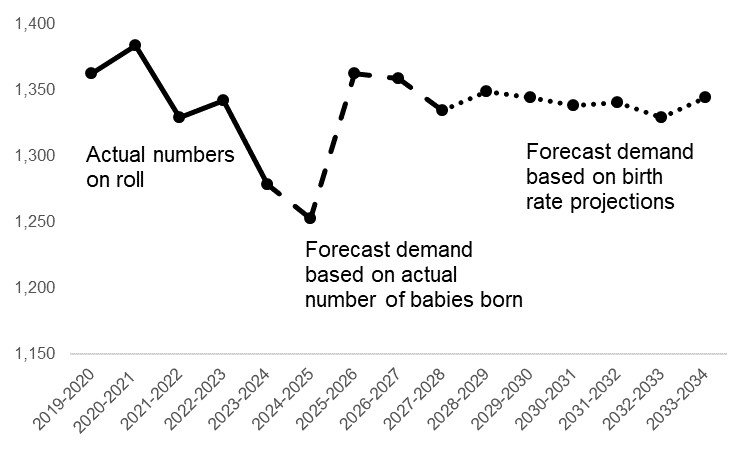
In academic year 2019 to 2020 there were around 1,400 pupils in year 7 in Guildford. Demand then sharply increased, reaching approximately 1,475 by 2023 to 2024. Year 7 demand is expected to fluctuate for the rest of the planning period, peaking in 2032 to 2033 at around 1,570 pupils.
Demand for year 7 places in Guildford
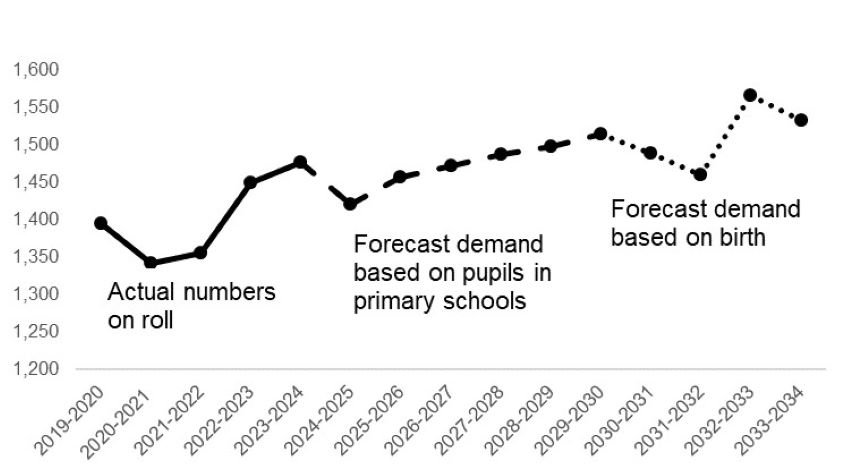
The number of children and young people aged 0 to 25 years with an EHCP residing in Guildford has increased by around 21% since January 2022.
EHCP demand for primary phase pupils is projected to increase from circa 530 pupils in academic year 2021 to 22 peaking at around 785 pupils in 2028 to 2029. Demand is then expected to decrease reaching around 745 pupils by 2033 to 2034.
For secondary phase pupils EHCP demand is expected to increase year on year from around 465 pupils in academic year 2021 to 2022 to its projected peak of approximately 780 pupils in 2032 to 2033.
For post-16 pupils EHCP demand is expected to increase year on year until the end of the planning period, peaking at around 500 pupils by academic year 2033 to 2034.
EHCP demand in Guildford
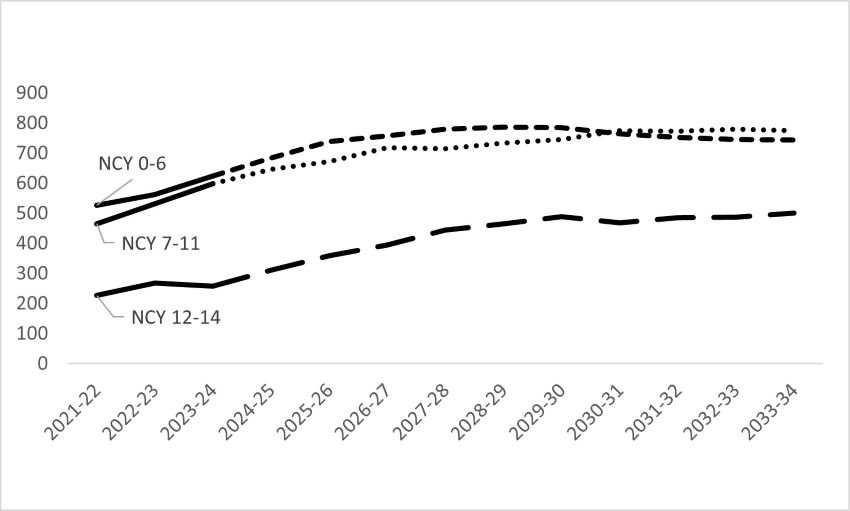
In 2023 to 2024 academic year, there were around 625 children and young people with an EHCP, residing in Guildford and attending a specialist provision (either maintained or non-maintained/independent) in school years Reception to 14.
For primary phase pupils living in Guildford who require a specialist school or specialist centre place, demand is expected to increase year on year to peaking in academic year 2028 to 2029 at 365 pupils. Demand is then projected to decrease reaching around 345 pupils by 2033 to 2034.
Secondary phase demand is projected to increase year on year from 280 pupils in academic year 2022 to 2023 to its peak of around 385 pupils in 2032 to 2033.
Post-16 demand for specialist places is expected to increase gradually year on year until academic year 2029 to 2030 when it peaks at around 85 pupils. Projections then indicate demand will gradually decline until the end of the planning period.
Demand for pupils living in Guildford who will require a specialist school or centre place
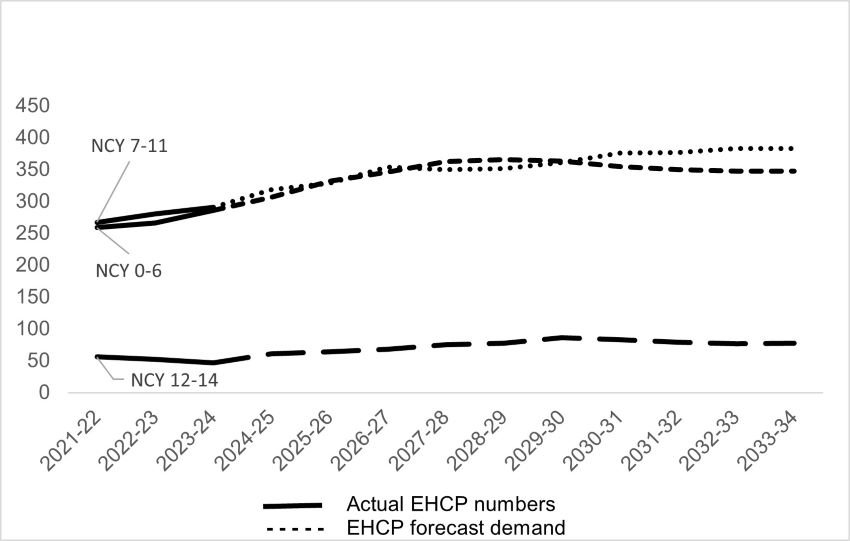
Mole Valley
The borough of Mole Valley is located in South East Surrey.
From a peak in 2010, births in Mole Valley have decreased or plateaued year on year since.
| Year | Number of births |
|---|---|
| 2010 | 887 |
| 2011 | 873 |
| 2012 | 868 |
| 2013 | 826 |
| 2014 | 800 |
| 2015 | 802 |
| 2016 | 770 |
| 2017 | 787 |
| 2018 | 775 |
| 2019 | 750 |
| 2020 | 703 |
| 2021 | 745 |
| 2022 | 728 |
| 2023 | 677 |
- At their highest births in the borough reached 887 in 2010.
- Since the peak in 2010, births have decreased by 24%, reaching a low of 677 in 2023. This is the lowest birth rate in the district in two decades.
As of academic year 2024 to 2025 Mole Valley has:
- 3 school based nurseries
- 1 maintained nursery
- 8 infant schools
- 3 junior schools
- 13 primary schools
- 4 secondary schools
- 4 specialist schools
- 5 specialist units (in mainstream schools)
- 3 sixth forms
As of April 2025, the above schools are comprised of the following school types:
| School type | % of schools |
|---|---|
| Academy | 52% |
| Community | 24% |
| Foundation | 0% |
| Free | 3% |
| Voluntary Aided | 18% |
| Voluntary Controlled | 3% |
As of April 2025, schools in Mole Valley have the following Ofsted ratings:
| Ofsted rating | Number of schools |
|---|---|
| Outstanding | 7 |
| Good | 23 |
| Requires Improvement | 3 |
| Inadequate | 0 |
| Schools which currently do not have a current Ofsted report | 0 |
Mole Valley is made up of five individual primary planning areas. Each primary phase school is allocated to one of these planning areas for the purpose of planning school places.
| Primary planning areas | Number of schools | Year Reception PAN | Year 3 PAN |
|---|---|---|---|
| Ashtead and Leatherhead | 6 | 292 | 66 |
| Brockham | 1 | 60 | 4 |
| Dorking Area | 7 | 250 | 25 |
| Fetcham and Bookham | 6 | 202 | 165 |
| South Mole Valley | 4 | 75 | 34 |
Mole Valley is separated into two planning areas, meaning that secondary places are planned to the north and south of the borough. For place planning purposes, Howard of Effingham School which is geographically located in Guildford is included in the Leatherhead secondary planning area.
| Secondary planning areas | Number of schools | Year 7 PAN |
|---|---|---|
| Dorking | 2 | 390 |
| Leatherhead | 3 | 690 |
Specialist school places are planned at a borough and quadrant level because it involves a significantly smaller number of pupils and because there is also a wider range of educational provision available.
For the academic year 2024 to 2025 there are 570 school places in specialist provision across the borough, categorised as follows:
| Need type | Type of provision | Number of places |
|---|---|---|
| Complex Autism, Communication and Interaction Needs | Specialist school | 143 |
| Moderate Learning Difficulty | Specialist school | 154 |
| Social, Emotional and Mental Health Needs | Specialist school | 73 |
| Severe Learning Difficulties | Specialist school | 99 |
| Autism, Communication and Interaction Needs | Specialist unit | 44 |
| Moderate Learning Difficulty | Specialist unit | 16 |
| Speech, Language and Communication Needs | Specialist unit | 41 |
Mainstream primary provision - 2024 to 2025 academic year
| Primary (NCY Reception to 6) school places | Primary (NCY Reception to 6) pupils on roll | Boys | Girls |
|---|---|---|---|
| 6,043 | 5,285 | 2,652 | 2,633 |
Mainstream secondary provision - 2024 to 2025 academic year
| Secondary (NCY 7 to 11) school places | Secondary (NCY 7 to11) pupils on roll | Boys | Girls |
|---|---|---|---|
| 3,990 | 3,916 | 2,087 | 1,829 |
(Please note number of places available are inclusive of schools who have capped their published admissions number in years 1-6 for primary and years 8-11 for secondary. Figures also include any bulge class provision across years Reception to 11 and any schools who may have more pupils on roll than their published admissions number)
Specialist provision - 2024 to 2025 academic year
| Specialist (NCY Reception to 14) school places | Specialist (NCY Reception to 14) pupils on roll | Boys | Girls |
|---|---|---|---|
| 570 | 577 | 445 | 132 |
As of academic year 2023 to 2024 there were around 880 pupils in years Reception to 14 with an EHCP residing in Mole Valley. Of these pupils approximately 43% require a specialist school or unit place. The most prevalent of all need types for both primary and secondary phase pupils in Mole Valley is ASD.
In January 2025, there were 476 students with an EHCP attending specialist schools in Mole Valley. They lived in the following areas:
| Location | Number of pupils |
|---|---|
| Mole Valley | 79 |
| Other borough in South East Surrey (Reigate and Banstead or Tandridge) | 134 |
| Elsewhere in Surrey | 247 |
| Out of county | 16 |
In January 2025, there were 101 children with an EHCP attending a specialist unit attached to a mainstream school in Mole Valley. They lived in the following areas:
| Location | Number of pupils |
|---|---|
| Mole Valley | 48 |
| Other borough in South East Surrey (Reigate and Banstead or Tandridge) | 15 |
| Elsewhere in Surrey | 38 |
| Out of county | 0 |
Demand for reception places in Mole Valley peaked at around 820 pupils in academic year 2019 to 2020. For academic year 2023 to 2024 there were approximately 760 pupils on roll. Projections are predicted to decline year-on-year from 2025 to 2026 reaching around 700 pupils by the end of the planning period.
Demand for reception places in Mole Valley

In academic year 2023 to 2024 there were around 800 pupils in year 7 in Mole Valley. Demand is projected to plateau at around 795 pupils before peaking at around 830 pupils in 2026 to 2027. Besides an outlier of around 810 in 2029 to 2030, Year 7 demand is then expected to fluctuate between 780 and 750 pupils for the rest of the planning period.
Demand for year 7 places in Mole Valley
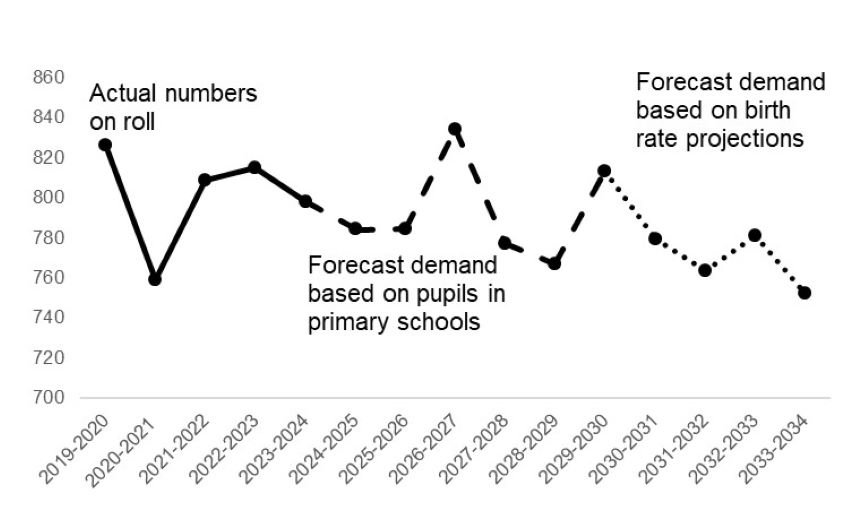
The number of children and young people aged 0 to 25 years with an EHCP residing in Mole Valley has increased by around 22% since January 2022.
EHCP demand for primary phase pupils is projected to increase year on year reaching around 405 pupils by academic year 2029 to 2030. Demand is then expected decrease annually reaching around 375 pupils by 2033 to 2034.
For secondary phase pupils, EHCP demand in Mole Valley is projected to peak at 490 pupils in academic year 2027 to 2028. Demand is then expected to fall throughout the rest of the planning period reaching around 440 pupils by 2033 to 2034.
For post-16 phase pupils, EHCP demand is expected to grow year on year from around 155 pupils in academic year 2023 to 2024 to its peak of around 335 pupils in 2030 to 2031. Demand is then expected to decrease annually until the end of the planning period.
EHCP demand in Mole Valley

In 2023 to 2024 academic year, there were around 380 children and young people with an EHCP, residing in Mole Valley and attending a specialist provision (either maintained or non-maintained/independent) in school years Reception to 14.
For primary phase pupils living in Mole Valley who require a specialist school or specialist centre place, demand is expected to peak at around 175 pupils in academic year 2029 to 2030 when demand is then projected to slowly decrease year on year until the end of the planning period.
Secondary phase demand is projected to peak at around 260 pupils requiring specialist provision in academic year 2027 to 2028. Demand is then expected to fluctuate for the rest of the planning period.
Post-16 forecasts are forecasted to increase year on year from around 30 pupils in academic year 2023 to 2024 to its peak of around 70 pupils in 2032 to 2033.
Demand for pupils living in Mole Valley who will require a specialist school or centre place
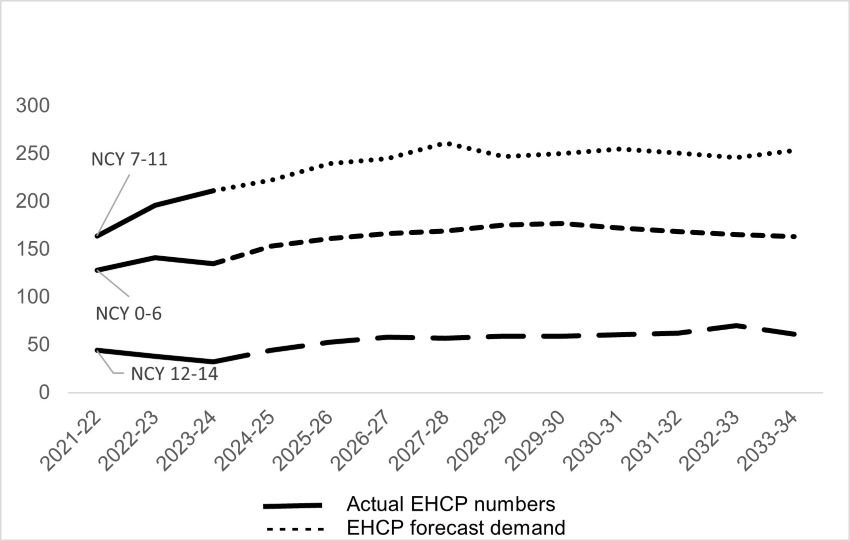
Reigate and Banstead
The borough of Reigate and Banstead is located in South East Surrey.
From a peak in 2010, births in Reigate and Banstead have fluctuated year on year since.
| Year | Number of births |
|---|---|
| 2010 | 1,889 |
| 2011 | 1,871 |
| 2012 | 1,872 |
| 2013 | 1,805 |
| 2014 | 1,844 |
| 2015 | 1,743 |
| 2016 | 1,796 |
| 2017 | 1,719 |
| 2018 | 1,709 |
| 2019 | 1,710 |
| 2020 | 1,677 |
| 2021 | 1,750 |
| 2022 | 1,618 |
| 2023 | 1,546 |
- At their highest births in the borough reached 1,889 in 2010.
- Since the peak in 2010, births have decreased by 19%, reaching a low of 1,546 in 2023.
As of academic year 2024 to 2025 Reigate and Banstead has:
- 14 school based nurseries
- 8 infant schools
- 6 junior schools
- 21 primary schools
- 1 all-through school (ages 7 to 18)
- 6 secondary schools
- 2 specialist schools
- 5 specialist units (in mainstream schools)
- 2 sixth forms
- 2 colleges
- 2 pupil referral units
As of April 2025, the above schools are comprised of the following school types:
| School type | % of schools |
|---|---|
| Academy | 50% |
| Community | 30% |
| Foundation | 2% |
| Free | 7% |
| Voluntary Aided | 11% |
| Voluntary Controlled | 0% |
As of April 2025, schools in Reigate and Banstead have the following Ofsted ratings:
| Ofsted Rating | Number of schools |
|---|---|
| Outstanding | 6 |
| Good | 39 |
| Requires Improvement | 1 |
| Inadequate | 0 |
| Schools which currently do not have a current Ofsted report | 0 |
Reigate and Banstead is made up of seven individual primary planning areas. Each primary phase school is allocated to one of these planning areas for the purpose of planning school places.
| Primary planning areas | Number of schools | Year Reception PAN | Year 3 PAN |
|---|---|---|---|
| Banstead and Woodmansterne | 4 | 210 | 90 |
| Earlswood and Salfords | 4 | 210 | 120 |
| Horley | 8 | 360 | 180 |
| Merstham | 4 | 148 | 60 |
| Redhill | 4 | 270 | 0 |
| Reigate | 5 | 300 | 210 |
| Tadworth, Walton and Preston | 7 | 285 | 66 |
Reigate and Banstead is a single secondary planning area, this means that demand for secondary places is estimated across the whole borough.
| Secondary planning areas | Number of schools | Year 7 PAN |
|---|---|---|
| Reigate and Redhill | 6 | 1,408 |
Specialist school places are planned at a borough and quadrant level because it involves a significantly smaller number of pupils and because there is also a wider range of educational provision available.
For the academic year 2024 to 2025 there are 442 school places in specialist provision across the borough, categorised as follows:
| Need type | Type of provision | Number of places |
|---|---|---|
| Complex Autism, Communication and Interaction Needs Severe Learning Difficulty | Specialist school | 163 |
| Moderate Learning Difficulty | Specialist school | 182 |
| Moderate Learning Difficulty | Specialist school satellite unit | 16 |
| Autism, Communication and Interaction Needs | Specialist unit | 34 |
| Moderate Learning Difficulty | Specialist unit | 14 |
| Speech, Language and Communication Needs | Specialist unit | 33 |
Mainstream primary provision - 2024 to 2025 academic year
| Primary (NCY Reception to 6) school places | Primary (NCY Reception to 6) pupils on roll | Boys | Girls |
|---|---|---|---|
| 12,670 | 11,607 | 5,836 | 5,771 |
Mainstream secondary provision - 2024 to 2025 academic year
| Secondary (NCY 7 to 11) school places | Secondary (NCY 7 to 11) pupils on roll | Boys | Girls |
|---|---|---|---|
| 8,202 | 7,918 | 4,024 | 3,894 |
(Please note number of places available are inclusive of schools who have capped their published admissions number in years 1-6 for primary and years 8-11 for secondary. Figures also include any bulge class provision across years Reception to 11 and any schools who may have more pupils on roll than their published admissions number)
Specialist provision - 2024 to 2025 academic year
| Specialist (NCY Reception to 14) school places | Specialist (NCY Reception to 4) pupils on roll | Boys | Girls |
|---|---|---|---|
| 442 | 442 | 282 | 160 |
As of academic year 2023 to 2024 there were around 1,700 pupils in years Reception to 14 with an EHCP residing in Reigate and Banstead. Of these pupils approximately 43% require a specialist school or unit place. The most prevalent of all need types for primary phase pupils in Reigate and Bansted is SLCN whilst for secondary phase pupils it is ASD.
In January 2025, there were 370 students with an EHCP attending specialist schools in Reigate and Banstead. They lived in the following areas:
| Location | Number of pupils |
|---|---|
| Reigate and Banstead | 199 |
| Other borough in South East Surrey (Mole Valley or Tandridge) | 134 |
| Elsewhere in Surrey | 28 |
| Out of county | 9 |
In January 2025, there were 72 children with an EHCP attending a specialist unit attached to a mainstream school in Reigate and Banstead They lived in the following areas:
| Location | Number of pupils |
|---|---|
| Reigate and Banstead | 51 |
| Other borough in South East Surrey (Mole Valley or Tandridge) | 18 |
| Elsewhere in Surrey | 2 |
| Out of county | 1 |
Demand for reception places in Reigate and Banstead reached around 1,700 pupils in academic year 2019 to 2020. Following this demand has been fluctuating and is expected to reach around 1,700 pupils again in 2025 to 2026. A sharp decline is predicted from 2027 to 2028, with approximately 1,480 pupils on roll, it is then projected that demand will plateau until the end of the planning period.
Demand for reception places in Reigate and Banstead
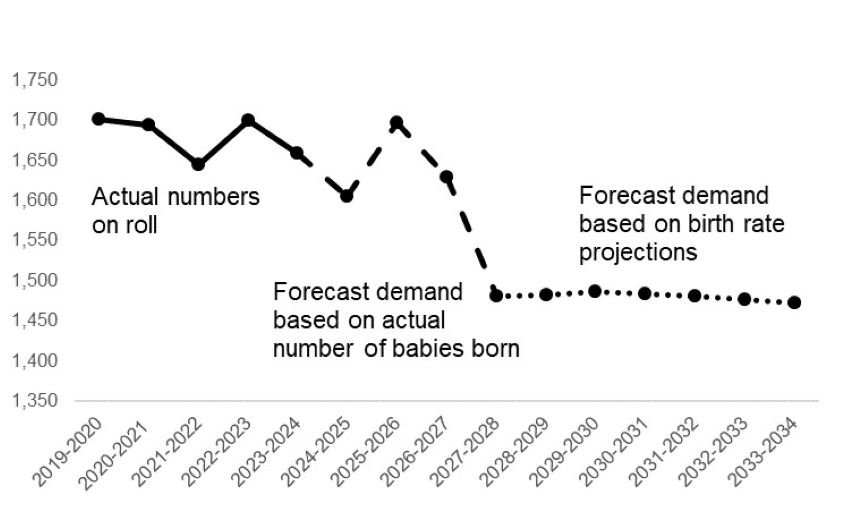
Demand for year 7 places in Reigate and Banstead increased year-on-year between 2020 to 2021 and 2022 to 2023 when it reached around 1,650 pupils. This is reflective of the higher birth rates. Demand for year 7 places is then expected to fluctuate across the planning period, with their lowest figure of approximately 1,570 in 2031 to 2032, immediately followed by a peak of around 1,660 in 2032 to 2033.
Demand for year 7 places in Reigate and Banstead
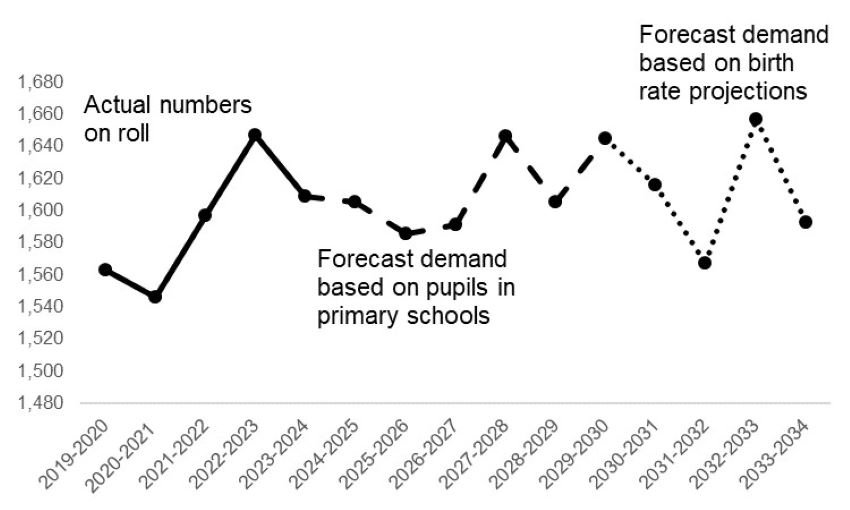
The number of children and young people aged 0 to 25 years with an EHCP residing in Reigate and Banstead has increased by around 25% since January 2022.
EHCP demand for primary phase pupils is projected to increase year on year reaching around 825 pupils by academic year 2026 to 2027. Demand is then expected decrease annually reaching around 690 pupils by 2033 to 2034.
For secondary phase pupils, EHCP demand in Reigate and Banstead is projected to peak at around 965 pupils in academic year 2029 to 2030. Demand is then expected to fall annually reducing to approximately 885 pupils in 2033 to 2034.
For post-16 phase pupils, EHCP demand is projected to increase year on year from around 295 pupils in academic year 2022 to 2023 before peaking at around 660 pupils in 2032 to 2033.
EHCP demand in Reigate and Banstead
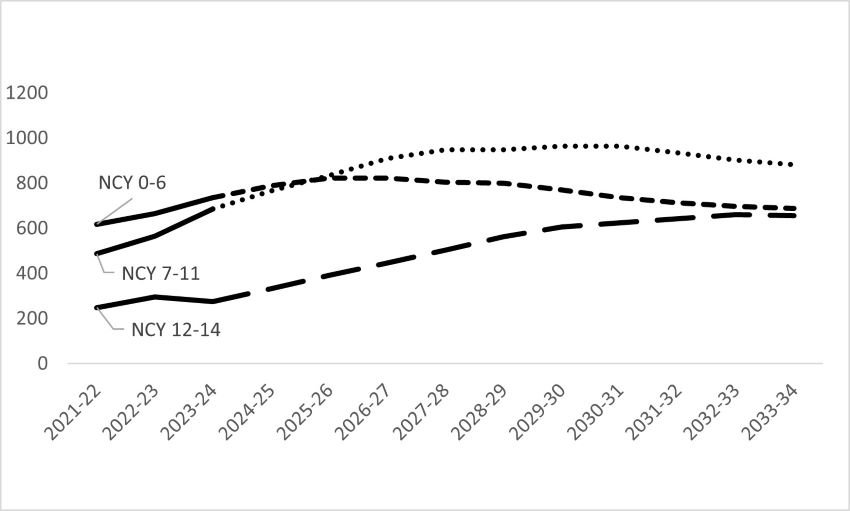
In 2023 to 2024 academic year, there were 735 children and young people with an EHCP, residing in Reigate and Banstead and attending a specialist provision (either maintained or non-maintained/independent) in school years Reception to 14.
For primary phase pupils living in Reigate and Banstead who require a specialist school or specialist centre place, demand has been growing year on year and is expected to peak at around 345 pupils in academic year 2025 to 2026. Demand is then projected to decrease year on year reaching approximately 290 pupils in 2033 to 2034.
Secondary phase demand is projected to increase year on year from around 330 pupils in academic year 2022 to 2023 to approximately 550 pupils in 2030 to 2031. Demand is then forecasted to decrease towards the end of the planning period to around 505 pupils.
Post-16 forecasts are forecasted to increase year on year from around 60 pupils in academic year 2022 to 23 to its peak of around 145 pupils in 2032 to 2033.
Demand for pupils living in Reigate and Banstead who will require a specialist school or centre place
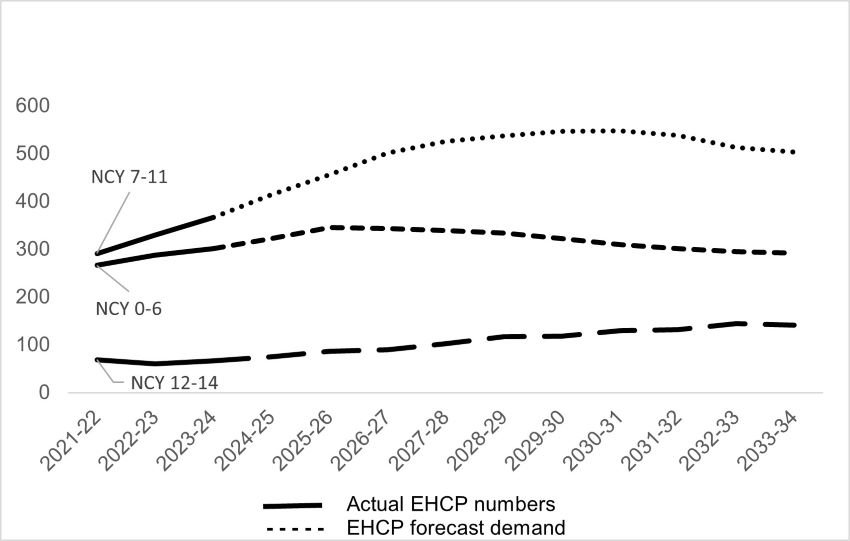
Runnymede
The borough of Runnymede is located in North West Surrey.
From a peak in 2011, births in Runnymede continue to fall, reaching a low in 2023.
| Year | Number of births |
|---|---|
| 2010 | 979 |
| 2011 | 1,007 |
| 2012 | 996 |
| 2013 | 931 |
| 2014 | 970 |
| 2015 | 964 |
| 2016 | 954 |
| 2017 | 893 |
| 2018 | 975 |
| 2019 | 895 |
| 2020 | 883 |
| 2021 | 934 |
| 2022 | 916 |
| 2023 | 879 |
- At their highest births in the borough reached 1,007 in 2011.
- Since the peak in 2011, births have decreased by 13%, reaching a low of 879 in 2023.
As of academic year 2024 to 2025 Runnymede has:
- 9 school based nurseries
- 1 maintained nursery
- 5 infant schools
- 4 junior schools
- 14 primary schools
- 5 secondary schools
- 1 specialist school
- 6 specialist units (in mainstream schools)
- 2 sixth forms
- 1 college
- 1 pupil referral unit
As of April 2025, the above schools are comprised of the following school types:
| School Types | % of schools |
|---|---|
| Academy | 48% |
| Community | 36% |
| Foundation | 0% |
| Free | 3% |
| Voluntary Aided | 13% |
| Voluntary Controlled | 0% |
As of April 2025, schools in Runnymede have the following Ofsted ratings:
| Ofsted rating | Number of schools |
|---|---|
| Outstanding | 3 |
| Good | 26 |
| Requires Improvement | 2 |
| Inadequate | 0 |
| Schools which currently do not have a current Ofsted report | 0 |
Runnymede is made up of four individual primary planning areas. Each primary phase school is allocated to one of these planning areas for the purpose of planning school places.
| Primary planning areas | Number of schools | Year Reception PAN | Year 3 PAN |
|---|---|---|---|
| Addlestone and Ottershaw | 9 | 330 | 150 |
| Chertsey | 4 | 150 | 0 |
| North Runnymede | 7 | 270 | 60 |
| Virginia Water, Lyne and Longcross | 3 | 90 | 60 |
Runnymede is a single secondary planning area, this means that demand for secondary places is estimated across the whole borough.
| Secondary planning areas | Number of schools | Year 7 PAN |
|---|---|---|
| Runnymede | 5 | 1,105 |
Specialist school places are planned at a borough and quadrant level because it involves a significantly smaller number of pupils and because there is also a wider range of educational provision available.
For the academic year 2024 to 2025 there are 406 school places in specialist provision across the borough, categorised as follows:
| Need type | Type of provision | Number of places |
|---|---|---|
| Complex Autism, Communication and Interaction Needs | Specialist school | 60 |
| Moderate Learning Difficulty | Specialist school | 210 |
| Moderate Learning Difficulty | Specialist school satellite unit | 20 |
| Autism, Communication and Interaction Needs | Specialist unit | 58 |
| Moderate Learning Difficulty | Specialist unit | 28 |
| Speech, Language and Communication Needs | Specialist unit | 30 |
(The Hythe Primary School serves pupils with either ASD or Moderate Learning Difficulties (MLD)
Mainstream primary provision - 2024 to 2025 academic year
| Primary (NCY Reception to 6) school places | Primary (NCY Reception to 6) pupils on roll | Boys | Girls |
|---|---|---|---|
| 5,772 | 5,499 | 2,744 | 2,755 |
Mainstream secondary provision - 2024 to 2025 academic year
| Secondary (NCY 7 to 11) school places | Secondary (NCY 7 to 11) pupils on roll | Boys | Girls |
|---|---|---|---|
| 5,284 | 5,153 | 2,620 | 2,533 |
(Please note number of places available are inclusive of schools who have capped their published admissions number in years 1-6 for primary and years 8-11 for secondary. Figures also include any bulge class provision across years Reception to 11 and any schools who may have more pupils on roll than their published admissions number)
Specialist provision - 2024 to 2025 academic year
| Specialist (NCY Reception to 14) school places | Specialist (NCY Reception to 14) pupils on roll | Boys | Girls |
|---|---|---|---|
| 406 | 394 | 270 | 124 |
As of academic year 2023 to 2024 there were around 925 pupils in years Reception to 14 with an EHCP residing in Runnymede. Of these pupils approximately 44% require a specialist school or unit place. The most prevalent of all need types for both primary and secondary phase pupils in Runnymede is ASD.
In January 2025, there were 290 students with an EHCP attending specialist schools in Runnymede. They lived in the following areas:
| Location | Number of pupils |
|---|---|
| Runnymede | 73 |
| Other borough in South East Surrey (Surrey Heath or Woking) | 38 |
| Elsewhere in Surrey | 167 |
| Out of county | 12 |
In January 2025, there were 104 children with an EHCP attending a specialist unit attached to a mainstream school in Runnymede. They lived in the following areas:
| Location | Number of pupils |
|---|---|
| Runnymede | 53 |
| Other borough in South East Surrey (Surrey Heath or Woking) | 24 |
| Elsewhere in Surrey | 26 |
| Out of county | 1 |
Demand for reception places in Runnymede dropped from circa 850 pupils in 2019 to 2020 to around 800 pupils in academic year 2021 to 2022. Demand is projected to peak in 2026 to 2027 at around 830 pupils, before declining year-on-year from 775 pupils to approximately 740 pupils between 2027 to 2028 and 2033 to 2034.
Demand for reception places in Runnymede
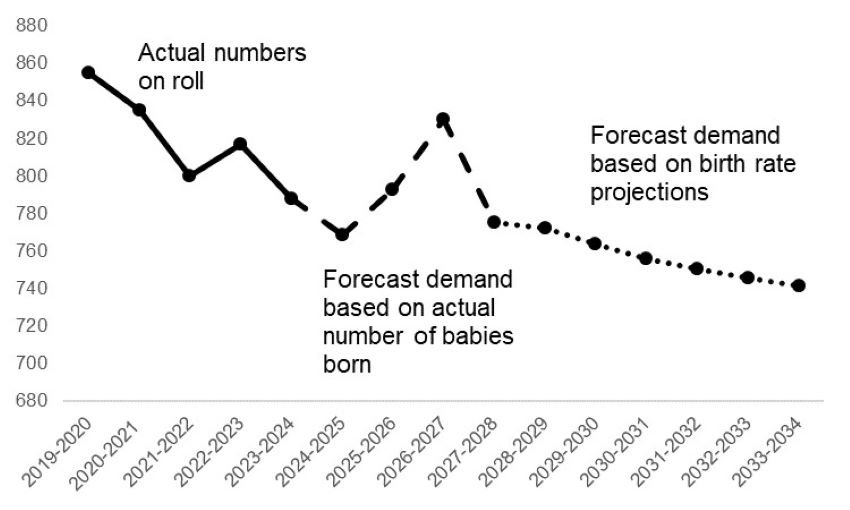
In academic year 2019 to 2020 there were approximately 1,085 pupils in year 7 in Runnymede. From 2025 to 2026 onwards demand for year 7 pupils is expected to rise year-on-year to approximately 1,200 pupils in 2029 to 2030 before fluctuating between 1,170 and 1,190 for the rest of the planning period.
Demand for year 7 places in Runnymede
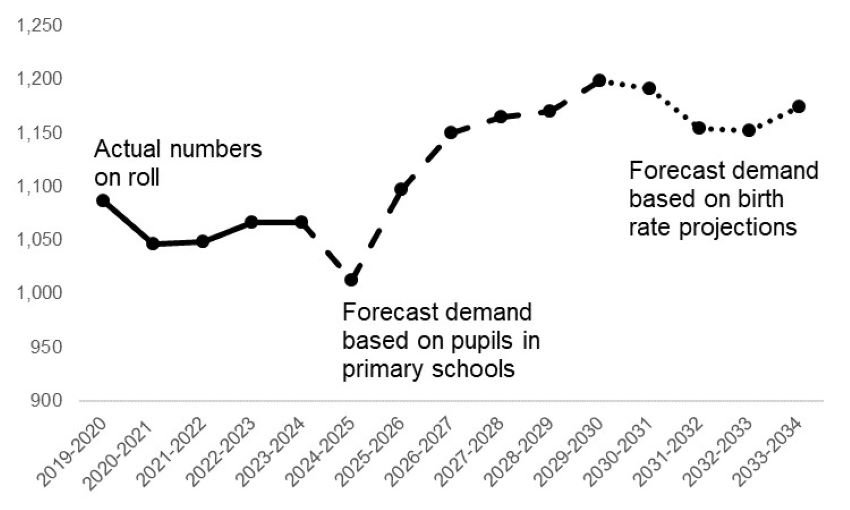
The number of children and young people aged 0 to 25 years with an EHCP residing in Runnymede has increased by around 20% since January 2022.
EHCP demand for primary phase pupils is projected to increase from around 415 pupils in academic year 2023 to 2024 to around 505 pupils in 2028 to 2029. Demand is then expected to decrease annually reaching around 455 pupils by 2033 to 2034.
For secondary phase pupils, EHCP demand in Runnymede reached around 310 pupils in academic year 2022 to 2023. Demand is expected to increase and is projected to peak at around 535 pupils in 2031 to 2032.
For post-16 phase pupils, EHCP demand is projected to increase from around 180 pupils in academic year 2022 to 2023, peaking at around 345 pupils in 2033 to 2034.
EHCP demand in Runnymede
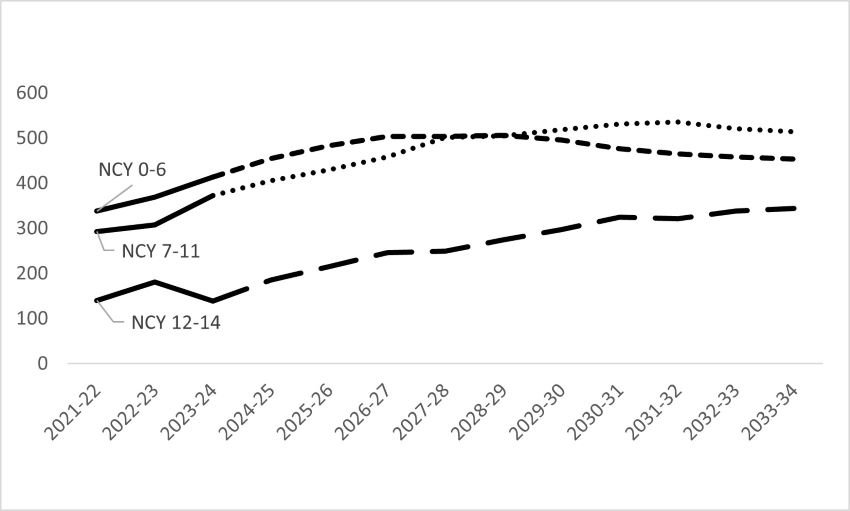
In 2023 to 2024 academic year, there were around 410 children and young people with an EHCP, residing in Runnymede and attending a specialist provision (either maintained or non-maintained/independent) in school years Reception to 14.
For primary phase pupils living in Runnymede who require a specialist school or specialist centre place, demand is expected to increase year on year and is expected to peak at around 220 pupils in academic year 2028 to 2029. Demand is then expected to slowly decrease year on year reaching around 200 pupils by the end of the planning period.
Secondary phase demand is projected to increase year on year from around 180 pupils in academic year 2022 to 2023 to approximately 280 pupils in 2031 to 2032. Demand is then expected to slowly decrease thereafter.
Post-16 forecasts are predicted to increase year on year throughout the planning growing from 35 pupils in academic year 2022 to 2023 and peaking in 2032 to 2033 at around 70 pupils.
Demand for pupils living in Runnymede who will require a specialist school or centre place
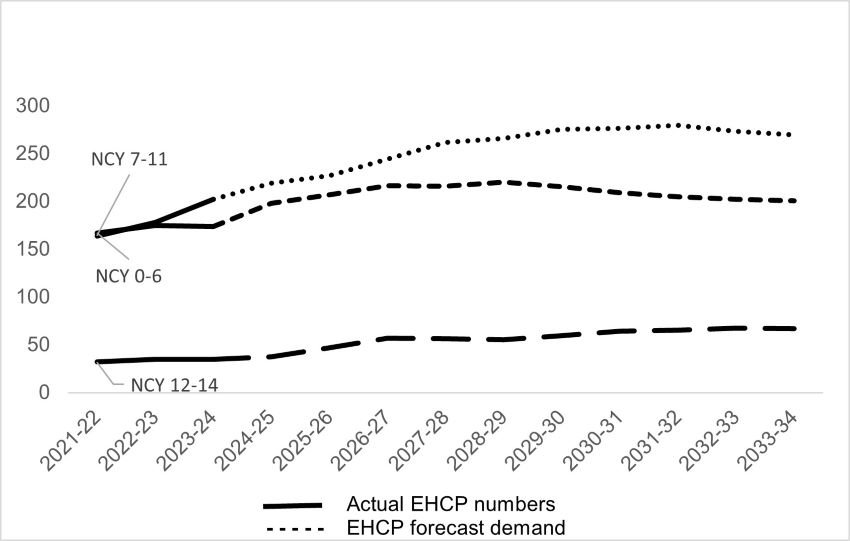
Spelthorne
The borough of Spelthorne is located in North East Surrey.
Spelthorne peak in birth rate in 2016 was later than the countywide peak. From a peak in 2016, births in Spelthorne continue to fall, reaching a low in 2022.
| Year | Number of births |
|---|---|
| 2010 | 1,228 |
| 2011 | 1,239 |
| 2012 | 1,224 |
| 2013 | 1,327 |
| 2014 | 1,260 |
| 2015 | 1,291 |
| 2016 | 1,346 |
| 2017 | 1,204 |
| 2018 | 1,229 |
| 2019 | 1,230 |
| 2020 | 1,119 |
| 2021 | 1,180 |
| 2022 | 1,110 |
| 2023 | 1,153 |
- At their highest births in the borough reached 1,346 in 2016
- Since the peak in 2016, births have decreased by 17.5%, reaching a low of 1,110 in 2022.
As of academic year 2024 to 2025 Spelthorne has:
- 11 school based nurseries
- 2 infant schools
- 0 junior schools
- 19 primary schools
- 6 secondary schools
- 1 specialist school
- 3 specialist units (in mainstream schools)
- 2 sixth forms
- 1 pupil referral unit
As of April 2025, the above schools are comprised of the following school types:
| School Type | % of schools |
|---|---|
| Academy | 58% |
| Community | 21% |
| Foundation | 7% |
| Free | 0% |
| Voluntary Aided | 14% |
| Voluntary Controlled | 0% |
As of April 2025, schools in Spelthorne have the following Ofsted ratings:
| Ofsted rating | Number of schools |
|---|---|
| Outstanding | 4 |
| Good | 23 |
| Requires Improvement | 1 |
| Inadequate | 1 |
| Schools which currently do not have a current Ofsted report | 0 |
Spelthorne is made up of five individual primary planning areas. Each primary phase school is allocated to one of these planning areas for the purpose of planning school places.
| Primary planning areas | Number of schools | Year Reception PAN | Year 3 PAN |
|---|---|---|---|
| Ashford | 7 | 450 | 0 |
| Shepperton | 3 | 150 | 36 |
| Staines and Laleham | 4 | 240 | 0 |
| Stanwell | 2 | 120 | 0 |
| Sunbury | 5 | 210 | 0 |
Spelthorne is a single secondary planning area, this means that demand for secondary places is estimated across the whole borough.
| Secondary planning areas | Number of schools | Year 7 PAN |
|---|---|---|
| Spelthorne | 6 | 1,246 |
Specialist school places are planned at a borough and quadrant level because it involves a significantly smaller number of pupils and because there is also a wider range of educational provision available.
For the academic year 2024 to 2025 there are 173 school places in specialist provision across the borough, categorised as follows:
| Need type | Type of provision | Number of places |
|---|---|---|
| Severe Learning Difficulties | Specialist school | 88 |
| Autism, Communication and Interaction Needs | Specialist unit | 84 |
| Moderate Learning Difficulty | Specialist unit | 1 |
Ashford Park Primary School serves pupils with either ASD or MLD.
Mainstream primary provision - 2024 to 2025 academic year
| Primary (NCY Reception to 6) school places | Primary (NCY Reception to 6) pupils on roll | Boys | Girls |
|---|---|---|---|
| 8,324 | 7,885 | 3,892 | 3,993 |
Mainstream secondary provision - 2024 to 2025 academic year
| Secondary (NCY 7 to11) school places | Secondary (NCY 7 to 11) pupils on roll | Boys | Girls |
|---|---|---|---|
| 6,002 | 5,722 | 2,963 | 2,759 |
(Please note number of places available are inclusive of schools who have capped their published admissions number in years 1-6 for primary and years 8-11 for secondary. Figures also include any bulge class provision across years Reception to 11 and any schools who may have more pupils on roll than their published admissions number)
Specialist provision - 2024 to 2025 academic year
| Specialist (NCY Reception to 14) school places | Specialist (NCY Reception to 14) pupils on roll | Boys | Girls |
|---|---|---|---|
| 173 | 167 | 117 | 50 |
As of academic year 2023 to 2024 there were around 1,300 pupils in years Reception to 14 with an EHCP residing in Spelthorne. Of these pupils approximately 44% require a specialist school or unit place. The most prevalent of all need types for both primary and secondary phase pupils in Spelthorne is ASD.
In January 2025, there were 86 students with an EHCP attending specialist schools in Spelthorne. They lived in the following areas:
| Location | Number of pupils |
|---|---|
| Spelthorne | 32 |
| Other borough in North East Surrey (Elmbridge or Epsom and Ewell) | 18 |
| Elsewhere in Surrey | 35 |
| Out of county | 1 |
In January 2025, there were 86 children with an EHCP attending a specialist unit attached to a mainstream school in Spelthorne. They lived in the following areas:
| Location | Number of pupils |
|---|---|
| Spelthorne | 32 |
| Other borough in North East Surrey (Elmbridge or Epsom and Ewell) | 18 |
| Elsewhere in Surrey | 35 |
| Out of county | 1 |
Demand for reception places in Spelthorne peaked at around 1,195 pupils in academic year 2020 to 2021. In academic year 2023 to 2024 there were approximately 1,100 pupils on roll. It is predicted demand will remain around this figure until 2026 to 2027, declining year-on-year from this point, with approximately 1,000 pupils on roll by the end of the planning period.
Demand for reception places in Spelthorne
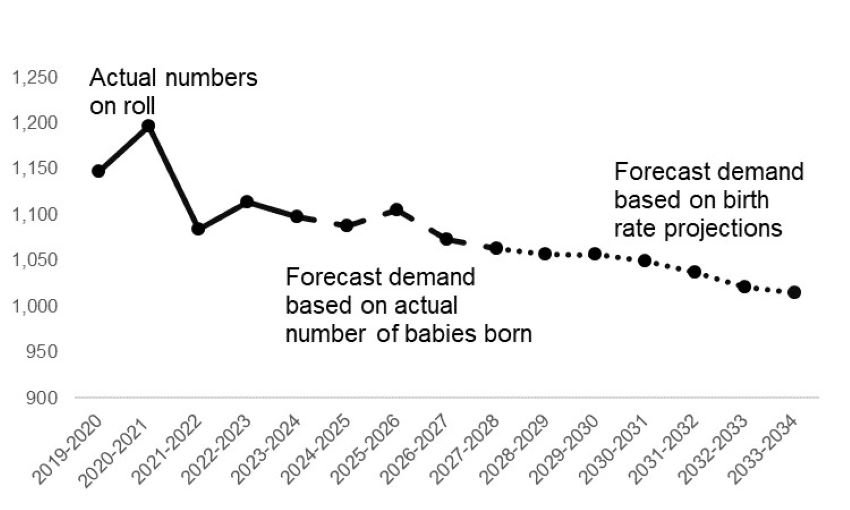
In academic year 2019 to 2020 there were around 1,190 pupils in year 7 in Spelthorne. Demand for year 7 places is projected to peak in 2027 to 2028 at around 1,310 pupils before reducing to around 1,275 pupils by the end of the planning period.
Demand for year 7 places in Spelthorne
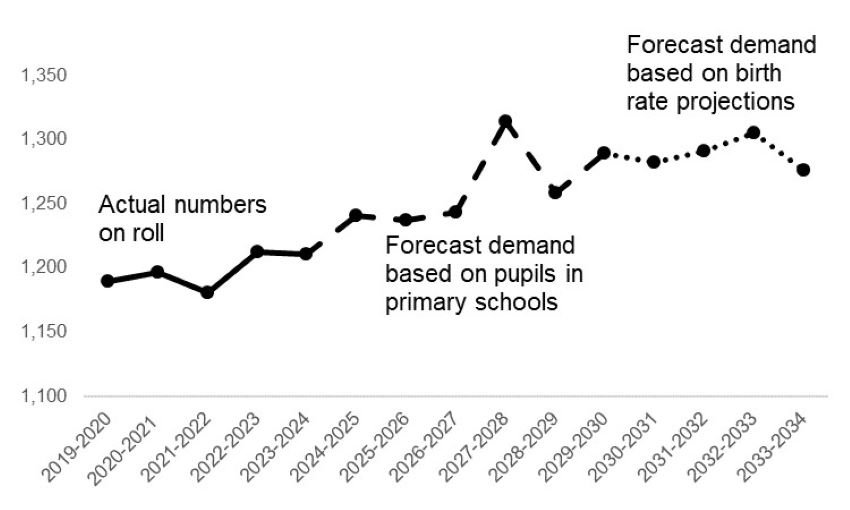
The number of children and young people aged 0 to 25 years with an EHCP residing in Spelthorne has increased by around 22% since January 2022.
EHCP demand for primary phase pupils is projected to increase year on year until academic year 2026 to 2027 peaking at around 595 pupils. Demand is then expected to decrease annually reaching around 520 pupils by 2033 to 2034.
For secondary phase pupils, EHCP demand in Spelthorne reached around 465 pupils in academic year 2022 to 2023. Demand is expected to increase and is projected to peak at around 680 pupils in 2027 to 2028. Demand is then projected to decrease year on year reaching around 620 pupils by 2033 to 2034.
For post-16 phase pupils, EHCP demand is projected to increase year on year from around 225 pupils in 2022 to 2023 and peaking at around 440 pupils in 2033 to 2034.
EHCP demand in Spelthorne
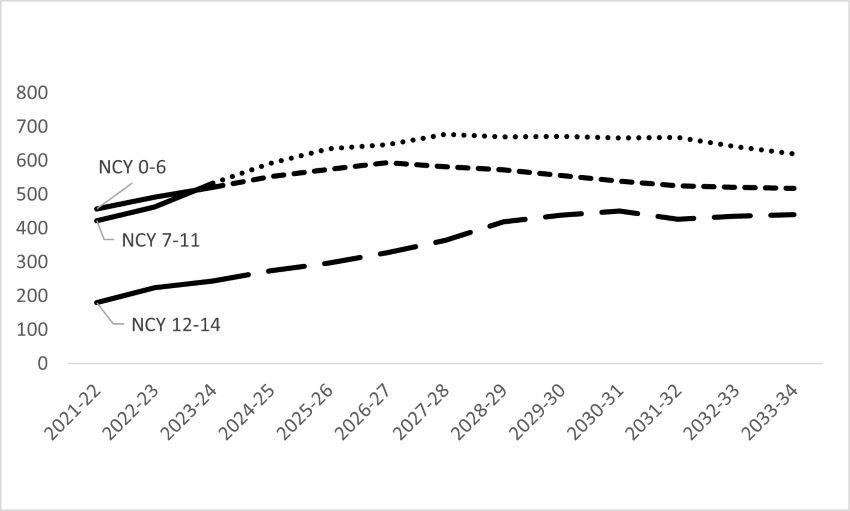
In 2023 to 2024 academic year, there were around 570 children and young people with an EHCP, residing in Spelthorne and attending a specialist provision (either maintained or non-maintained/independent) in school years Reception to 14.
For primary phase pupils living in Spelthorne who require a specialist school or specialist centre place, demand is expected to increase year on year peaking in academic year 2026 to 2027 at around 265 pupils. Demand is then projected to slowly decrease year on year until the end of the planning period when it will reach around 240 pupils.
Secondary phase demand is projected to increase year on year from around 295 pupils in academic year 2022 to 2023 to approximately 390 pupils in 2029 to 2030. Demand is then expected to slowly decrease year on year until the end of the planning period reaching circa 370 pupils.
Post-16 forecasts are predicted to increase year on year throughout the planning period growing from 45 pupils in academic year 2022 to 2023 and peaking in 2029 to 2030 at around 100 pupils.
Demand for pupils living in Spelthorne who will require a specialist school or centre place
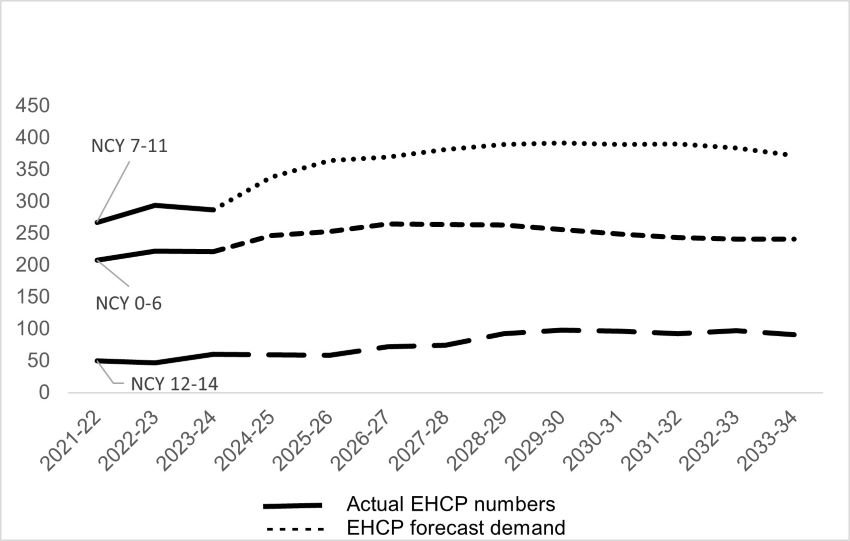
Surrey Heath
The borough of Surrey Heath is located in North West Surrey.
Surrey Heath birth rate peaked in 2008 which was earlier than the countywide peak. From its peak in 2008, births in Surrey Heath have decreased or plateaued, reaching a low in 2018.
| Year | Number of births |
|---|---|
| 2010 | 959 |
| 2011 | 974 |
| 2012 | 940 |
| 2013 | 945 |
| 2014 | 932 |
| 2015 | 972 |
| 2016 | 884 |
| 2017 | 865 |
| 2018 | 792 |
| 2019 | 837 |
| 2020 | 798 |
| 2021 | 874 |
| 2022 | 838 |
| 2023 | 849 |
- At their highest births in the borough reached 1,029 in 2008.
- Since the peak in 2008, births have decreased by 23%, reaching a low of 792 in 2018.
As of academic year 2024 to 2025 Surrey Heath has:
- 9 school based nurseries
- 11 infant schools
- 6 junior schools
- 8 primary schools
- 4 secondary schools
- 3 specialist schools
- 3 specialist units (in mainstream schools)
- 2 sixth forms
As of April 2025, the above schools are comprised of the following school types:
| School Types | % of schools |
|---|---|
| Academy | 81% |
| Community | 13% |
| Foundation | 0% |
| Free | 0% |
| Voluntary Aided | 6% |
| Voluntary Controlled | 0% |
As of April 2025, schools in Surrey Heath have the following Ofsted ratings:
| Ofsted rating | Number of schools |
|---|---|
| Outstanding | 5 |
| Good | 25 |
| Requires Improvement | 2 |
| Inadequate | 0 |
| Schools which currently do not have a current Ofsted report | 0 |
Surrey Heath is made up of five individual primary planning areas. Each primary phase school is allocated to one of these planning areas for the purpose of planning school places.
| Primary planning areas | Number of schools | Year Reception PAN | Year 3 PAN |
|---|---|---|---|
| Chobham, West End and Bisley | 3 | 150 | 0 |
| Frimley and Heatherside | 5 | 240 | 159 |
| Frimley Green, Mytchett and Deepcut | 5 | 180 | 96 |
| North Camberley | 6 | 210 | 120 |
| Windlesham, Bagshot and Lightwater | 6 | 210 | 180 |
Surrey Heath is a single secondary planning area, this means that demand for secondary places is estimated across the whole borough.
| Secondary planning areas | Number of schools | Year 7 PAN |
|---|---|---|
| Surrey Heath | 4 | 870 |
Specialist school places are planned at a borough and quadrant level because it involves a significantly smaller number of pupils and because there is also a wider range of educational provision available.
For the academic year 2024 to 2025 there are 434 school places in specialist provision across the borough, categorised as follows:
| Need type | Type of provision | Number of places |
|---|---|---|
| Moderate Learning Difficulties | Specialist school | 160 |
| Severe Learning Difficulties Profound and Multiple Learning Difficulties | Specialist school | 142 |
| Social, Emotional and Mental Health Needs | Specialist school | 82 |
| Moderate Learning Difficulty | Specialist school satellite unit | 20 |
| Autism, Communication and Interaction Needs | Specialist unit | 7 |
| Speech, Language and Communication Needs | Specialist unit | 23 |
Mainstream primary provision - 2024 to 2025 academic year
| Primary (NCY Reception to6) school places | Primary (NCY Reception to 6) pupils on roll | Boys | Girls |
|---|---|---|---|
| 7,034 | 6,378 | 3,307 | 3,071 |
Mainstream secondary provision - 2024 to 2025 academic year
| Secondary (NCY 7 to 11) school places | Secondary (NCY 7 to 11) pupils on roll | Boys | Girls |
|---|---|---|---|
| 4,493 | 4,476 | 2,265 | 2,211 |
(Please note number of places available are inclusive of schools who have capped their published admissions number in years 1-6 for primary and years 8-11 for secondary. Figures also include any bulge class provision across years Reception to 11 and any schools who may have more pupils on roll than their published admissions number)
Specialist provision - 2024 to 2025 academic year
| Specialist (NCY Reception to 14) school places | Specialist (NCY Reception to 14) pupils on roll | Boys | Girls |
|---|---|---|---|
| 434 | 436 | 303 | 133 |
As of academic year 2023 to 2024 there were around 840 pupils in years Reception to 14 with an EHCP residing in Surrey Heath. Of these pupils approximately 41% require a specialist school or unit place. The most prevalent of all need types for both primary and secondary phase pupils in Surrey Heath is ASD.
In January 2025, there were 406 students with an EHCP attending specialist schools in Surrey Heath. They lived in the following areas:
| Location | Number of pupils |
|---|---|
| Surrey Heath | 101 |
| Other borough in North West Surrey (Runnymede or Woking) | 93 |
| Elsewhere in Surrey | 149 |
| Out of county | 63 |
In January 2025, there were 30 children with an EHCP attending a specialist unit attached to a mainstream school in Surrey Heath. They lived in the following areas:
| Location | Number of pupils |
|---|---|
| Surrey Heath | 26 |
| Other borough in North West Surrey (Runnymede or Woking) | 0 |
| Elsewhere in Surrey | 3 |
| Out of county | 1 |
Demand for reception places in Surrey Heath peaked at around 980 pupils in academic year 2020 to 2021. By academic year 2022 to 2023 this had reduced to approximately 870 pupils. Demand is expected to fluctuate throughout the rest of the planning period.
Demand for reception places in Surrey Heath
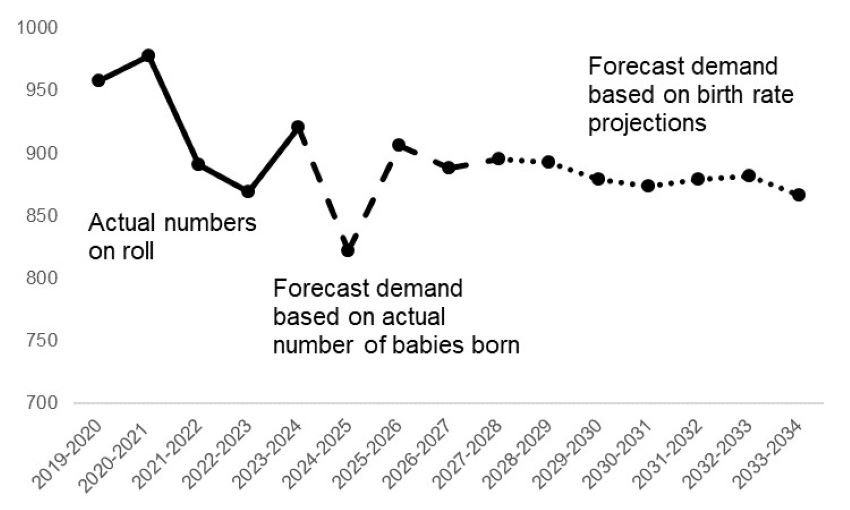
Demand for year 7 places in Surrey Heath is projected to fluctuate throughout the planning period. In academic year 2023 to 2024 there were around 940 pupils on roll, it is predicted there will be around 800 pupils on roll in 2031 to 2032. With this exception, the planning period fluctuates between around 840 and 880 pupils.
Demand for year 7 places in Surrey Heath
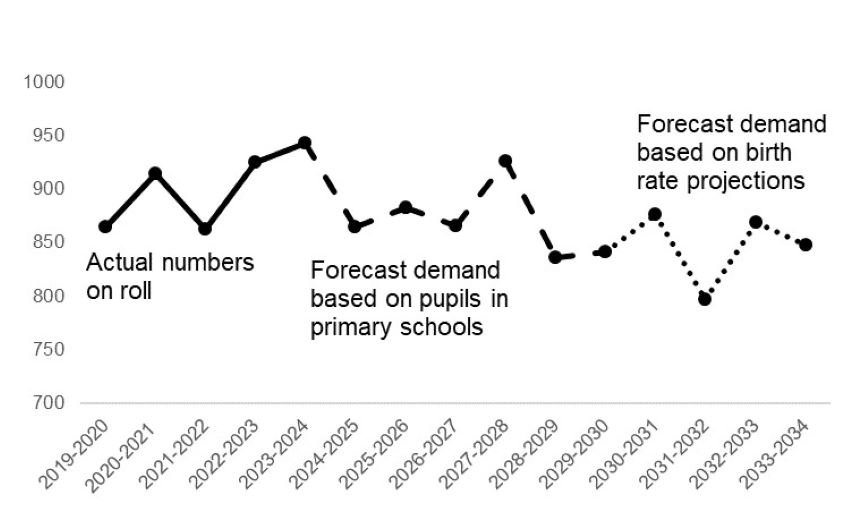
The number of children and young people aged 0 to 25 years with an EHCP residing in Surrey Heath has increased by around 21% since January 2022.
EHCP demand for primary phase pupils is projected to increase year on year until academic year 2029 to 2030 peaking at around 500 pupils. Demand is then expected to slowly decrease at around 475 pupils by 2033 to 2034.
For secondary phase pupils, EHCP demand in Surrey Heath reached around 310 pupils in academic year 2022 to 2023. Demand is expected to increase year on year peaking at around 480 pupils in 2033 to 2034.
For post-16 phase pupils, EHCP demand is projected to increase year on year from around 130 pupils in academic year 2022 to 2023 peaking at around 290 pupils in 2032 to 2033.
EHCP demand in Surrey Heath
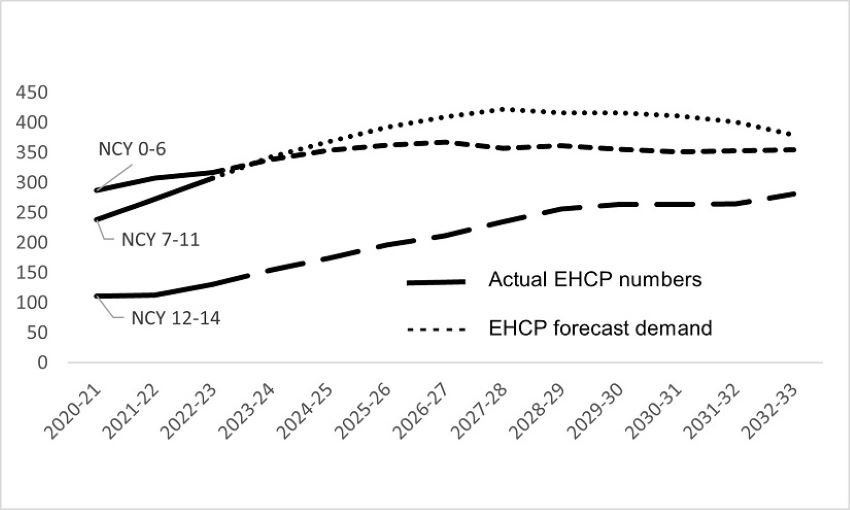
In 2023 to 2024 academic year, there were around 345 children and young people with an EHCP, residing in Surrey Heath and attending a specialist provision (either maintained or non-maintained/independent) in school years Reception to 14.
For primary phase pupils living in Surrey Heath who require a specialist school or specialist centre place, demand is expected to increase year on year peaking in academic year 2029 to 2030 at around 200 pupils. Demand is then projected to plateau at around 190 pupils for the rest of the planning period.
Secondary phase demand is projected to increase from around 170 pupils in academic year 2022 to 2023 to approximately 265 pupils in 2033 to 2034 when demand reaches its peak.
Post-16 forecasts are predicted to increase from around 20 pupils in academic year 2022 to 2023 to 60 pupils in 2032 to 2033 when demand reaches its peak.
Demand for pupils living in Surrey Heath who will require a specialist school or centre place
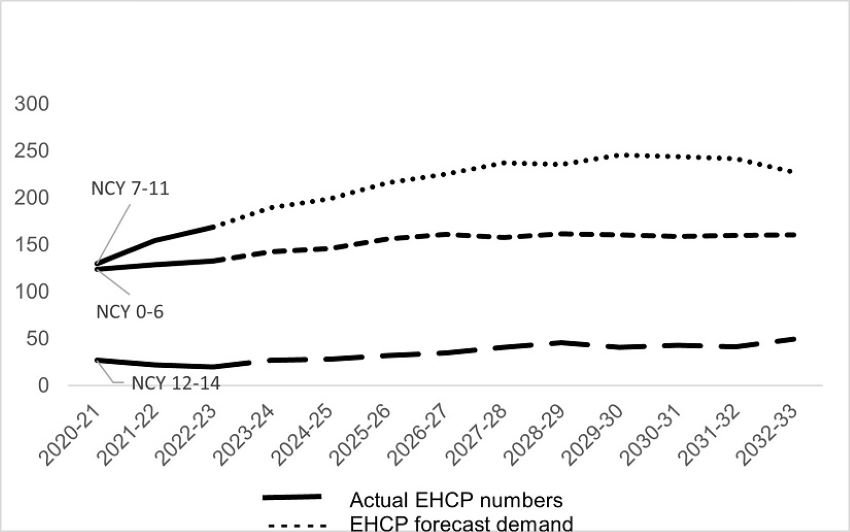
Tandridge
The borough of Tandridge is located in South East Surrey.
Tandridge peak in birth rate in 2018 was later than the countywide peak. From its peak in 2018, births in Tandridge have fluctuated.
| Year | Number of births |
|---|---|
| 2010 | 908 |
| 2011 | 913 |
| 2012 | 966 |
| 2013 | 892 |
| 2014 | 904 |
| 2015 | 964 |
| 2016 | 956 |
| 2017 | 916 |
| 2018 | 984 |
| 2019 | 894 |
| 2020 | 896 |
| 2021 | 983 |
| 2022 | 826 |
| 2023 | 851 |
- At their highest births in the borough reached 984 in 2018
- Since the peak in 2018, births have decreased by 16%, reaching a low of 826 in 2022. This is the lowest birth rate in the district in two decades.
As of academic year 2024 to 2025 Tandridge has:
- 11 school based nurseries
- 3 infant schools
- 1 junior school
- 20 primary schools
- 3 secondary schools
- 3 specialist schools
- 4 specialist units (in mainstream schools)
- 2 sixth forms
As of April 2025, the above schools are comprised of the following school types:
| School Type | % of schools |
|---|---|
| Academy | 60% |
| Community | 17% |
| Foundation | 3% |
| Free | 0% |
| Voluntary Aided | 20% |
| Voluntary Controlled | 0% |
As of April 2025, schools in Tandridge have the following Ofsted ratings:
| Ofsted rating | Number of schools |
|---|---|
| Outstanding | 4 |
| Good | 26 |
| Requires Improvement | 0 |
| Inadequate | 0 |
| Schools which currently do not have a current Ofsted report | 0 |
Tandridge is made up of five individual primary planning areas. Each primary phase school is allocated to one of these planning areas for the purpose of planning school places.
| Primary planning areas | Number of schools | Year Reception PAN | Year 3 PAN |
|---|---|---|---|
| Caterham | 6 | 270 | 0 |
| Godstone | 4 | 120 | 0 |
| North East Tandridge | 5 | 210 | 0 |
| Oxted and Limpsfield | 5 | 180 | 120 |
| South Tandridge | 4 | 180 | 2 |
Tandridge is a single secondary planning area, this means that demand for secondary places is estimated across the whole borough.
| Secondary planning areas | Number of schools | Year 7 PAN |
|---|---|---|
| Tandridge | 3 | 755 |
Specialist school places are planned at a borough and quadrant level because it involves a significantly smaller number of pupils and because there is also a wider range of educational provision available.
For the academic year 2024 to 2025 there are 326 school places in specialist provision across the borough, categorised as follows:
| Need type | Type of provision | Number of places |
|---|---|---|
| Severe Learning Difficulties | Specialist school | 85 |
| Autism, Communication and Interaction Needs | Specialist school | 175 |
| Visual Impairment Needs | Specialist unit | 24 |
| Speech, Language and Communication Needs | Specialist unit | 21 |
| Autism, Communication and Interaction Needs | Specialist unit | 21 |
Mainstream primary provision - 2024 to 2025 academic year
| Primary (NCY Reception to 6) school places | Primary (NCY Reception to 6) pupils on roll | Boys | Girls |
|---|---|---|---|
| 6,774 | 6,282 | 3,152 | 3,110 |
Mainstream secondary provision - 2024 to 2025 academic year
| Secondary (NCY 7 to 11) school places | Secondary (NCY 7 to 11) pupils on roll | Boys | Girls |
|---|---|---|---|
| 3,439 | 3,291 | 1,669 | 1,622 |
(Please note number of places available are inclusive of schools who have capped their published admissions number in years 1-6 for primary and years 8-11 for secondary. Figures also include any bulge class provision across years Reception to 11 and any schools who may have more pupils on roll than their published admissions number)
Specialist provision - 2024 to 2025 academic year
| Specialist (NCY Reception to 14) school places | Specialist (NCY Reception to14) pupils on roll | Boys | Girls |
|---|---|---|---|
| 326 | 316 | 182 | 134 |
As of academic year 2023 to 2024 there were around 950 pupils in years Reception to 14 with an EHCP residing in Tandridge. Of these pupils approximately 41% require a specialist school or unit place. The most prevalent of all need types for primary phase pupils in Tandridge is SLCN whilst for secondary phase pupils it is ASD.
In January 2025, there were 263 students with an EHCP attending specialist schools in Tandridge. They lived in the following areas:
| Location | Number of pupils |
|---|---|
| Tandridge | 64 |
| Other borough in South East Surrey (Mole Valley or Reigate and Banstead) | 98 |
| Elsewhere in Surrey | 42 |
| Out of county | 59 |
In January 2025, there were 53 children with an EHCP attending a specialist unit attached to a mainstream school in Tandridge They lived in the following areas:
| Location | Number of pupils |
|---|---|
| Tandridge | 23 |
| Other borough in South East Surrey (Mole Valley or Reigate and Banstead) | 22 |
| Elsewhere in Surrey | 2 |
| Out of county | 6 |
Demand for reception places in Tandridge peaked in 2020 to 2021, with around 950 pupils on roll. The borough has seen a gradual decline since, with around 915 pupils on roll in 2023 to 2024. In 2026 to 2027 this figure is predicted to fall below 850 pupils. Projections anticipate that demand will decline year-on-year, reaching approximately 800 pupils come the end of the planning period.
Demand for reception places in Tandridge
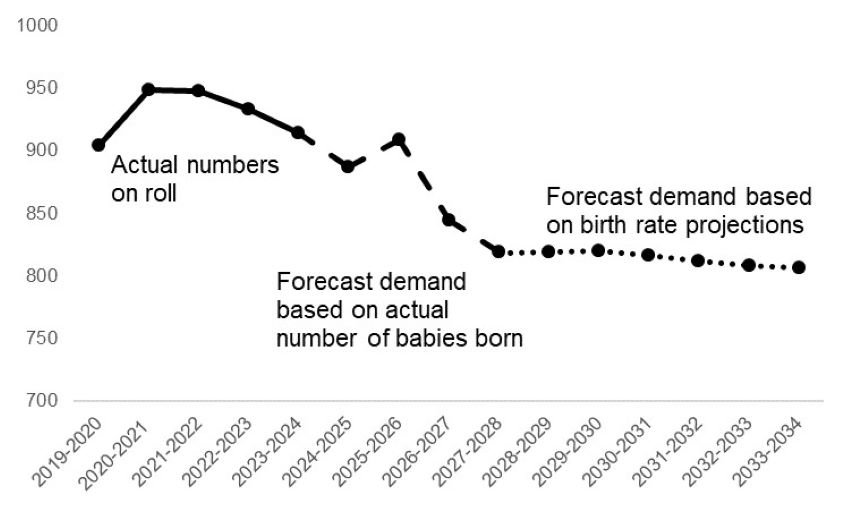
Demand for year 7 places in Tandridge dropped to around 650 pupils in 2021 to 2022, this had risen to around 725 pupils by 2023 to 2024. Demand is expected to fluctuate between 675 and 790 pupils between 2024 to 2025 and 2033 to 2034, peaking at around 790 pupils in 2028 to 2029.
Demand for year 7 places in Tandridge

The number of children and young people aged 0 to 25 years with an EHCP residing in Tandridge has increased by around 24% since January 2022.
EHCP demand for primary phase pupils is projected to increase year on year until academic year 2028 to 2029 peaking at around 455 pupils. Demand is then expected to slowly decrease to around 410 pupils by the end of the planning period.
For secondary phase pupils, EHCP demand in Tandridge reached around 335 pupils in academic year 2022 to 2023. Demand is expected to increase and is projected to peak at around 500 pupils in 2030 to 2031. Demand is then expected to plateau for the rest of the planning period.
For post-16 phase pupils, EHCP demand is projected to increase year on year from around 185 pupils in academic year 2022 to 2023 peaking at around 370 pupils in 2030 to 2031.
EHCP demand in Tandridge
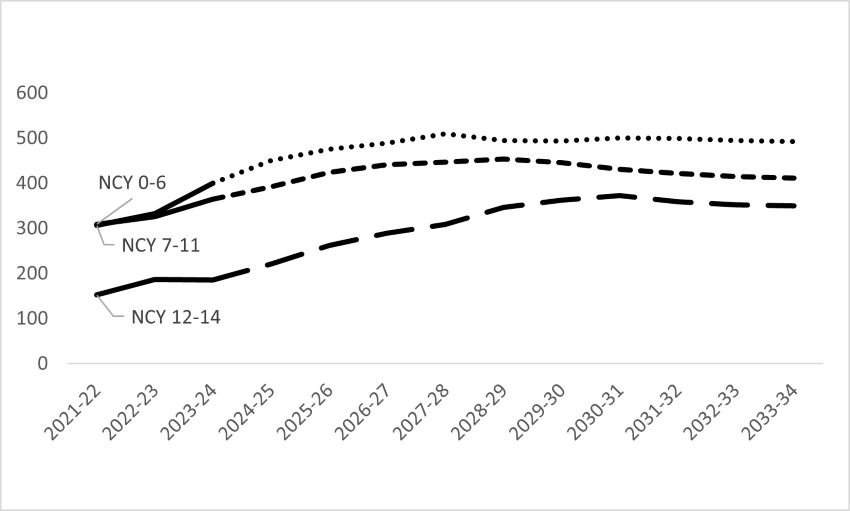
In 2023 to 2024 academic year, there were 385 children and young people with an EHCP, residing in Tandridge and attending a specialist provision (either maintained or non-maintained/independent) in school years Reception to 14.
For primary phase pupils living in Tandridge who require a specialist school or specialist centre place, demand is expected to peak at around 165 pupils in academic year 2028 to 2029. Demand is then projected to plateau for the rest of the planning period.
Secondary phase demand is projected to increase from around 210 pupils in academic year 2022 to 2023 to approximately 295 pupils in 2033 to 2034 when demand reaches its peak.
Post-16 forecasts are predicted to increase from around 40 pupils in academic year 2022 to 2023 to 85 pupils in 2029 to 2030 when demand reaches its peak.
Demand for pupils living in Tandridge who will require a specialist school or centre place
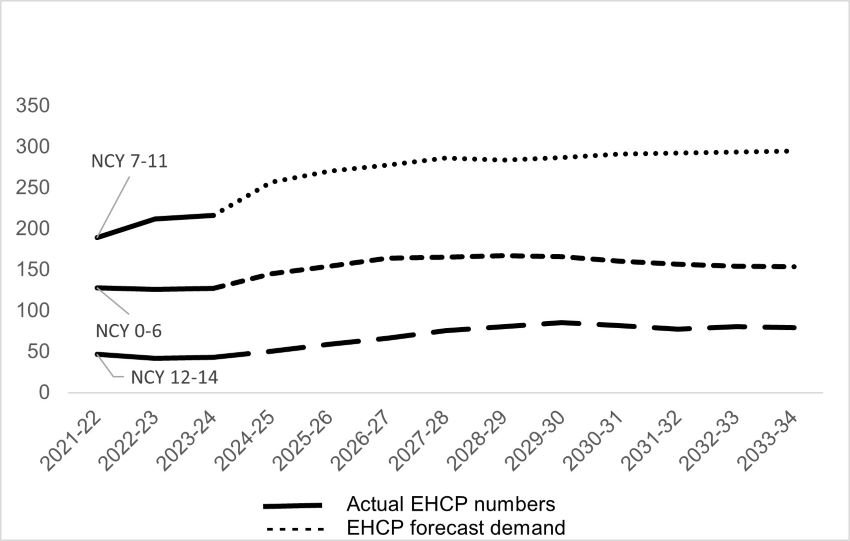
Waverley
The borough of Waverley is located in South West Surrey.
From a peak in 2012, births in Waverley have fluctuated year on year since.
| Year | Number of births |
|---|---|
| 2010 | 1,306 |
| 2011 | 1,296 |
| 2012 | 1,385 |
| 2013 | 1,240 |
| 2014 | 1,214 |
| 2015 | 1,282 |
| 2016 | 1,251 |
| 2017 | 1,211 |
| 2018 | 1,191 |
| 2019 | 1,133 |
| 2020 | 1,040 |
| 2021 | 1,207 |
| 2022 | 1,075 |
| 2023 | 1,089 |
- At their highest births in the borough reached 1,385 in 2012
- Since the peak in 2012, births have decreased by 25%, reaching a low of 1,040 in 2020. This is the lowest birth rate in the district in two decades.
As of academic year 2024 to 2025 Waverley has:
- 5 school based nurseries
- 1 maintained nursery
- 14 infant schools
- 5 junior schools
- 19 primary schools
- 7 secondary schools
- 4 specialist schools
- 6 specialist units (in mainstream schools)
- 1 sixth forms
- 2 colleges
As of April 2025, the above schools are comprised of the following school types:
| School Type | % of schools |
|---|---|
| Academy | 56% |
| Community | 10% |
| Foundation | 8% |
| Free | 0% |
| Voluntary Aided | 22% |
| Voluntary Controlled | 4% |
As of April 2025, schools in Waverley have the following Ofsted ratings:
| Ofsted rating | Number of schools |
|---|---|
| Outstanding | 9 |
| Good | 37 |
| Requires Improvement | 1 |
| Inadequate | 3 |
| Schools which currently do not have a current Ofsted report | 0 |
Waverley is made up of seven individual primary planning areas. Each primary phase school is allocated to one of these planning areas for the purpose of planning school places. For place planning purposes, St Mary's CofE Voluntary Controlled Infant School and Puttenham CofE School which are geographically both located in Guildford are included in the Waverley primary planning area.
| Primary planning areas | Number of schools | Year Reception PAN | Year 3 PAN |
|---|---|---|---|
| Cranleigh | 4 | 150 | 30 |
| Farnham | 6 | 360 | 86 |
| Godalming | 9 | 300 | 120 |
| Hale and Weybourne | 4 | 135 | 90 |
| Haslemere and Hindhead | 6 | 210 | 72 |
| Milford and Witley | 3 | 90 | 90 |
| West Waverley | 6 | 150 | 120 |
Waverley is split into three separate secondary planning areas and demand is projected across these areas, one of which overlaps the borough boundary. For place planning purposes, Ash Manor which is geographically located in Guildford is included in the Farnham and Ash secondary primary planning area.
| Secondary planning areas | Number of schools | Year 7 PAN |
|---|---|---|
| Farnham and Ash | 4 | 1,050 |
| Godalming | 3 | 510 |
| Haslemere and Hindhead | 1 | 180 |
Specialist school places are planned at a borough and quadrant level because it involves a significantly smaller number of pupils and because there is also a wider range of educational provision available.
For the academic year 2024 to 2025 there are 589 school places in specialist provision across the borough, categorised as follows:
| Need type | Type of provision | Number of places |
|---|---|---|
| Autism, Communication and Interaction Needs | Specialist school | 154 |
| Moderate Learning Difficulty | Specialist school | 158 |
| Social, Emotional and Mental Health Difficulties | Specialist school | 63 |
| Severe Learning Difficulties | Specialist school | 109 |
| Speech, Language and Communication Needs | Specialist unit | 60 |
| Autism, Communication and Interaction Needs | Specialist unit | 33 |
| Moderate Learning Difficulty | Specialist unit | 12 |
Mainstream primary provision - 2024 to 2025 academic year
| Primary (NCY Reception to 6) school places | Primary (NCY Reception to 6) pupils on roll | Boys | Girls |
|---|---|---|---|
| 9,963 | 9,206 | 4,660 | 4,546 |
Mainstream secondary provision - 2024 to 2025 academic year
| Secondary (NCY 7 to 11) school places | Secondary (NCY 7 to 11) pupils on roll | Boys | Girls |
|---|---|---|---|
| 7,289 | 7,178 | 3,570 | 3,608 |
(Please note number of places available are inclusive of schools who have capped their published admissions number in years 1-6 for primary and years 8-11 for secondary. Figures also include any bulge class provision across years Reception to 11 and any schools who may have more pupils on roll than their published admissions number)
Specialist provision - 2024 to 2025 academic year
| Specialist (NCY Reception to 14) school places | Specialist (NCY Reception to 14) pupils on roll | Boys | Girls |
|---|---|---|---|
| 589 | 604 | 448 | 156 |
As of academic year 2023 to 2024 there were around 1,385 pupils in years Reception to 14 with an EHCP residing in Waverley. Of these pupils approximately 46% require a specialist school or unit place. The most prevalent of all need types for primary phase pupils in Waverley is SLCN whilst for secondary phase pupils it is ASD.
In January 2025, there were 503 students with an EHCP attending specialist schools in Waverley. They lived in the following areas:
| Location | Number of pupils |
|---|---|
| Waverley | 185 |
| Other borough in South West Surrey (Guildford) | 100 |
| Elsewhere in Surrey | 155 |
| Out of county | 63 |
In January 2025, there were 101 children with an EHCP attending a specialist unit attached to a mainstream school in Waverley. They lived in the following areas:
| Location | Number of pupils |
|---|---|
| Waverley | 56 |
| Other borough in South West Surrey (Guildford) | 32 |
| Elsewhere in Surrey | 12 |
| Out of county | 1 |
Demand for reception places in Waverley reached around 1,360 pupils on roll in academic year 2020 to 2021. By 2023 to 2024, this had fallen to around 1,250. It is projected that demand will remain steady for the next few years, before gradually declining year-on-year to around 1,180 pupils by the end of the planning period.
Demand for reception places in Waverley
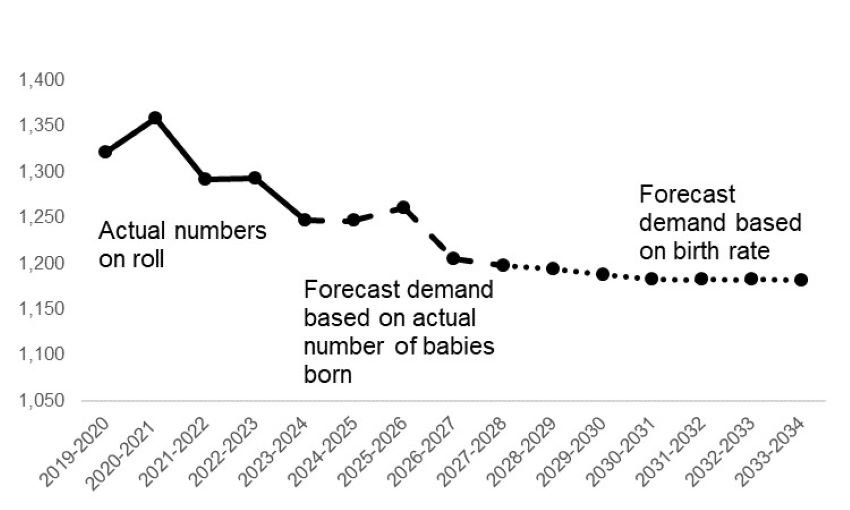
In academic year 2019 to 2020 there were around 1,400 pupils in year 7 in Waverley. Demand has grown year on year reaching around 1,500 in 2023 to 2024. Demand is expected to fluctuate through the rest of the planning period, peaking at around 1,490 in 2028 to 2029 and dipping to approximately 1,380 in 2033 to 2034.
Demand for year 7 places in Waverley
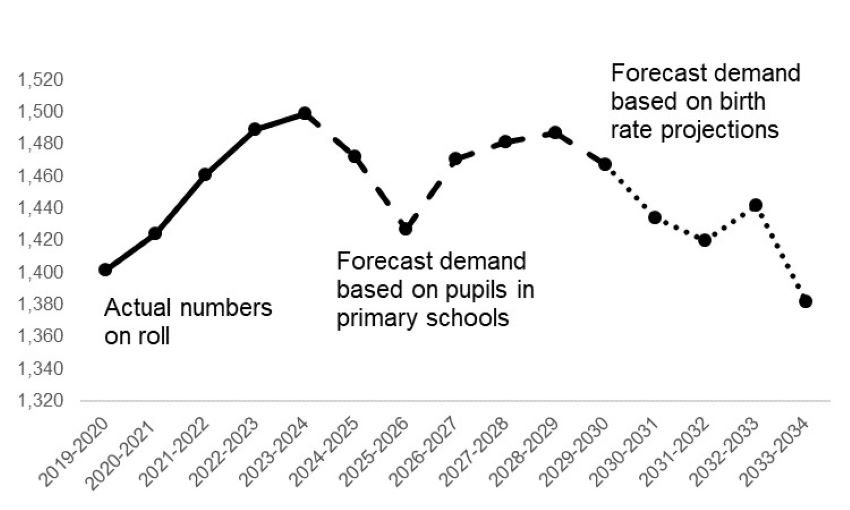
The number of children and young people aged 0 to 25 years with an EHCP residing in Waverley has increased by around 20% since January 2022.
EHCP demand for primary phase pupils is projected to increase year on year until academic year 2026 to 2027 peaking at around 565 pupils. Demand is then expected to decrease reaching around 495 pupils by 2033 to 2034.
For secondary phase pupils, EHCP demand in Waverley reached around 530 pupils in academic year 2022 to 2023. Demand is then expected to increase and is projected to peak at around 750 pupils in 2027 to 2028. Demand is then projected to decrease dropping to around 640 pupils in 2033 to 2034.
For post-16 phase pupils, EHCP demand is projected to increase year on year from around 270 pupils in academic year 2022 to 2023 peaking at around 505 pupils in 2030 to 2031.
EHCP demand in Waverley
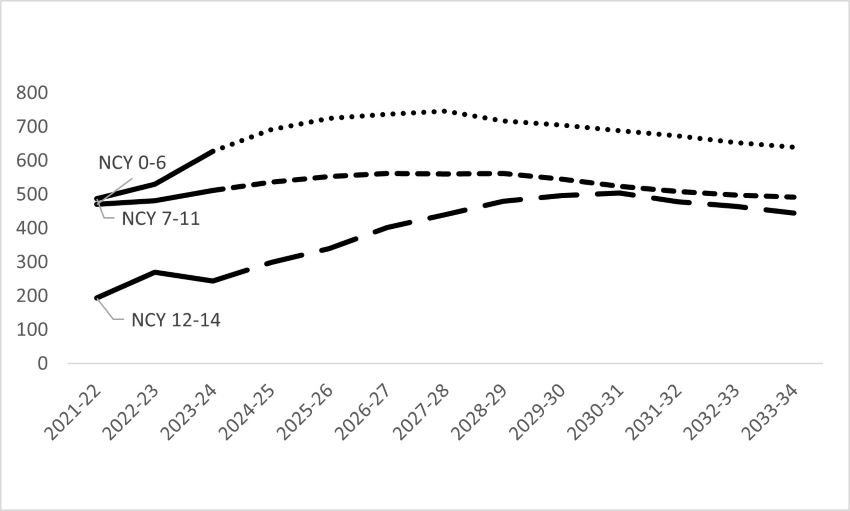
In 2023 to 2024 academic year, there were around 640 children and young people with an EHCP, residing in Waverley and attending a specialist provision (either maintained or non-maintained/independent) in school years Reception to 14.
EHCP demand for primary phase pupils is projected to increase year on year until academic year 2028 to 2029 peaking at around 250 pupils. Demand is then expected to decrease reaching around 225 pupils by 2033 to 2034.
Secondary phase demand is projected to increase from around 345 pupils in academic year 2022 to 2023 to approximately 455 pupils in 2027 to 2028. Demand is then expected to decline year on year reaching around 390 pupils by the end of the planning period.
Post-16 forecasts are predicted to increase from around 75 pupils in academic year 2022 to 2023 to approximately 140 pupils in 2030 to 2031 when demand reaches its peak. Projections then indicate a drop in demand reaching around 115 pupils by the end of the planning period.
Demand for pupils living in Waverley who will require a specialist school or centre place
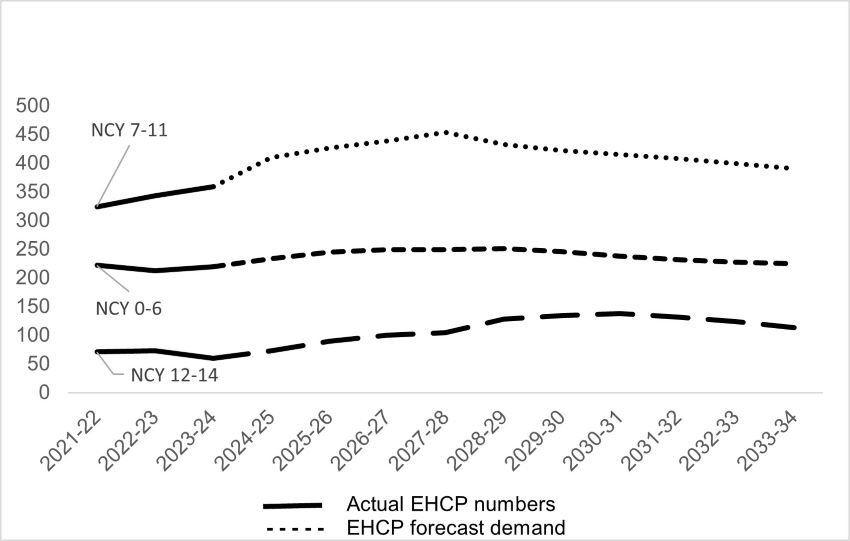
Woking
The borough Woking is located in North West Surrey.
From a peak in 2012, births in Woking have decreased or plateaued year on year since.
| Year | Number of births |
|---|---|
| 2010 | 1,476 |
| 2011 | 1,448 |
| 2012 | 1,531 |
| 2013 | 1,311 |
| 2014 | 1,358 |
| 2015 | 1,298 |
| 2016 | 1,337 |
| 2017 | 1,291 |
| 2018 | 1,286 |
| 2019 | 1,177 |
| 2020 | 1,185 |
| 2021 | 1,121 |
| 2022 | 1,124 |
| 2023 | 1,080 |
- At their highest births in the borough reached 1,531 in 2012
- Since the peak in 2012, births have decreased by 30%, reaching a low of 1,080 in 2023.
As of academic year 2024 to 2025 Woking has:
- 13 school based nurseries
- 4 infant schools
- 4 junior schools
- 17 primary schools
- 5 secondary schools
- 2 specialist schools
- 3 specialist units (in mainstream schools)
- 2 sixth forms
- 1 colleges
- 1 pupil referral unit
As of April 2025, the above schools are comprised of the following school type:
| School Type | % of schools |
|---|---|
| Academy | 73% |
| Community | 12% |
| Foundation | 3% |
| Free | 3% |
| Voluntary Aided | 6% |
| Voluntary Controlled | 3% |
As of April 2025, schools in Woking have the following Ofsted ratings:
| Ofsted rating | Number of schools |
|---|---|
| Outstanding | 6 |
| Good | 24 |
| Requires Improvement | 2 |
| Inadequate | 1 |
| Schools which currently do not have a current Ofsted report | 0 |
Woking is made up of five individual primary planning areas. Each primary phase school is allocated to one of these planning areas for the purpose of planning school places. For place planning purposes, Send CofE Primary School and Pirbright Village Primary School which are geographically both located in Guildford are included in the Woking primary planning area.
| Primary planning areas | Number of schools | Year Reception PAN | Year 3 PAN |
|---|---|---|---|
| Byfleet and West Byfleet | 6 | 300 | 90 |
| Horsell and Goldsworth | 5 | 300 | 90 |
| Knaphill | 8 | 270 | 180 |
| Sheerwater and Maybury | 4 | 180 | 0 |
| South Woking | 4 | 210 | 0 |
Woking is a single secondary planning area, this means that demand for secondary places is estimated across the whole borough.
| Secondary planning areas | Number of schools | Year 7 PAN |
|---|---|---|
| Woking | 5 | 1,080 |
Specialist school places are planned at a borough and quadrant level because it involves a significantly smaller number of pupils and because there is also a wider range of educational provision available.
For the academic year 2024 to 2025 there are 385 school places in specialist provision across the borough, categorised as follows:
| Need type | Type of provision | Number of places |
|---|---|---|
| Complex Autism, Communication and Interaction Needs | Specialist school | 242 |
| Moderate Learning Difficulty | Specialist school | 110 |
| Moderate Learning Difficulty | Specialist unit | 16 |
| Visual Impairment Needs | Specialist unit | 17 |
Mainstream primary provision - 2024 to 2025 academic year
| Primary (NCY Reception 6) school places | Primary (NCY Reception to 6) pupils on roll | Boys | Girls |
|---|---|---|---|
| 8,280 | 7,969 | 4,053 | 3,916 |
Mainstream secondary provision - 2024 to 2025 academic year
| Secondary (NCY 7 to 11) school places | Secondary (NCY 7 to 11) pupils on roll | Boys | Girls |
|---|---|---|---|
| 5,495 | 5.478 | 2,789 | 2,689 |
(Please note number of places available are inclusive of schools who have capped their published admissions number in years 1-6 for primary and years 8-11 for secondary. Figures also include any bulge class provision across years Reception to 11 and any schools who may have more pupils on roll than their published admissions number)
Specialist provision - 2024 to 2025 academic year
| Specialist (NCY Reception to 14) school places | Specialist (NCY Reception to 14) pupils on roll | Boys | Girls |
|---|---|---|---|
| 385 | 377 | 281 | 96 |
As of academic year 2023 to 2024 there were around 1,150 pupils in years Reception to 14 with an EHCP residing in Woking. Of these pupils approximately 44% require a specialist school or unit place. The most prevalent of all need types for both primary and secondary phase pupils in Woking is ASD.
In January 2025, there were 355 students with an EHCP attending specialist schools in Woking. They lived in the following areas:
| Location | Number of pupils |
|---|---|
| Woking | 130 |
| Other borough in North West Surrey (Runnymede or Surrey Heath) | 92 |
| Elsewhere in Surrey | 127 |
| Out of county | 6 |
In January 2025, there were 22 children with an EHCP attending a specialist unit attached to a mainstream school in Woking. They lived in the following areas:
| Location | Number of pupils |
|---|---|
| Woking | 10 |
| Other borough in North West Surrey (Runnymede or Surrey Heath) | 4 |
| Elsewhere in Surrey | 6 |
| Out of county | 2 |
Demand for reception places in Woking peaked at around 1,225 pupils in 2019 to 2020. In academic year 2023 to 2024 there were approximately 1,130 pupils on roll. Projections for reception pupils in Woking are expected to fall year-on-year reaching around 940 by 2033 to 2034.
Demand for reception places in Woking
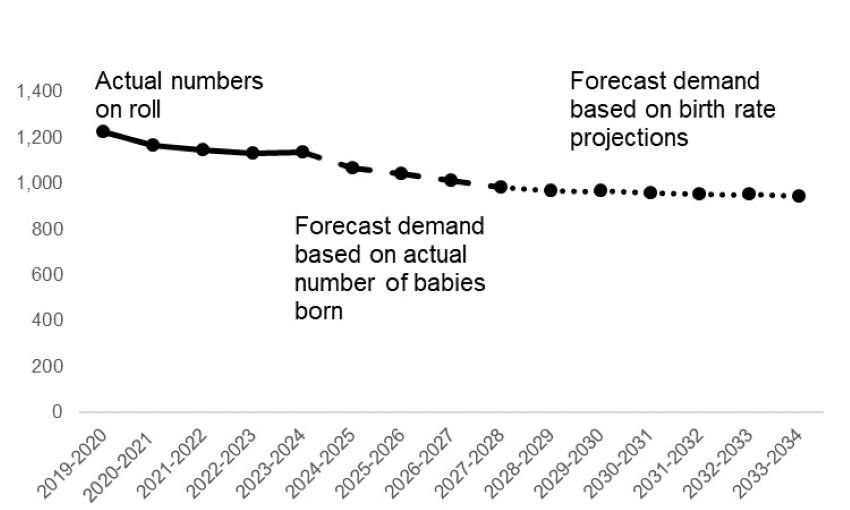
Demand for year 7 places in Woking is projected to fluctuate throughout the planning period. In academic year 2023 to 2024 there were around 1,180 pupils on roll, and following peaks and troughs throughout the planning period is predicted to drop to around 1,000 pupils by 2033 to 2034.
Demand for year 7 places in Woking
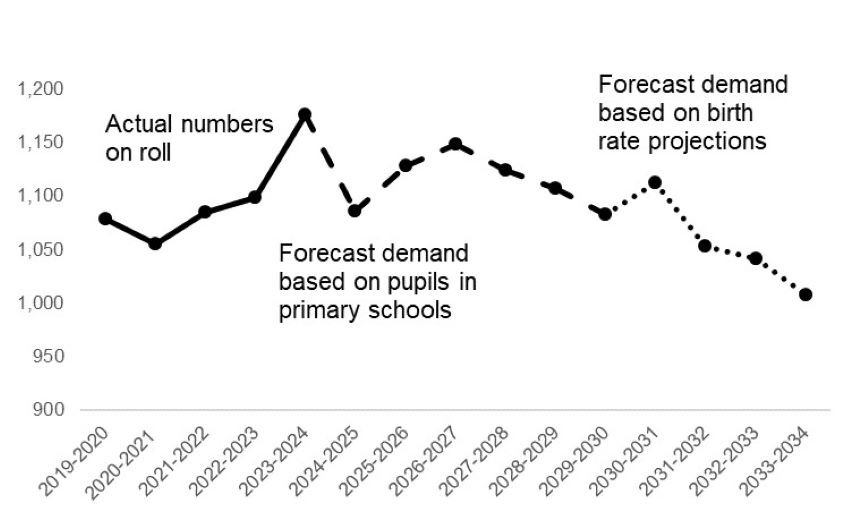
The number of children and young people aged 0 to 25 years with an EHCP residing in Woking has increased by around 19% since January 2022.
EHCP demand for primary phase pupils is projected to increase year on year until academic year 2025 to 2026, peaking at around 545 pupils. Demand is then expected to decrease annually reaching around 450 pupils in 2033 to 2034.
For secondary phase pupils, EHCP demand in Woking reached around 410 pupils in academic year 2022 to 2023. Demand is expected to increase year on year peaking in 2029 to 2030 at 555 pupils before decreasing to around 505 pupils in 2033 to 2034.
For post-16 phase pupils, EHCP demand is projected to increase year on year from around 190 pupils in academic year 2022 to 2023, peaking at around 370 pupils in 2032 to 2033.
EHCP demand in Woking
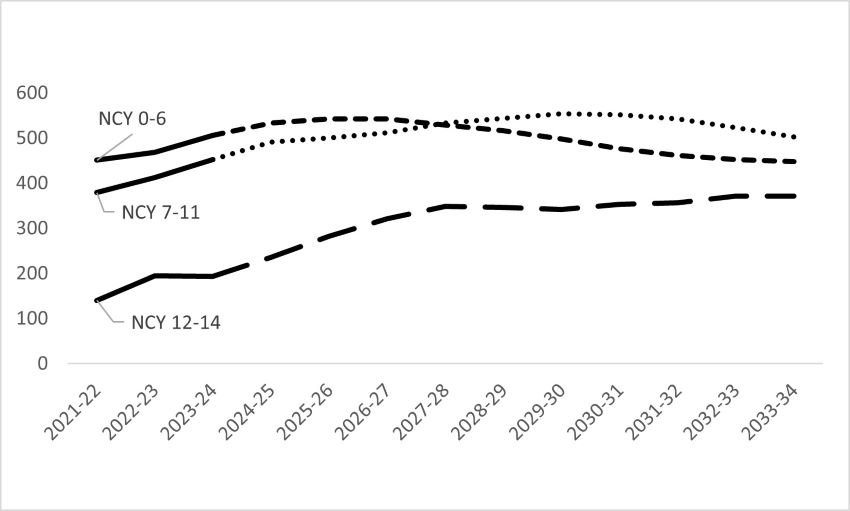
In 2023 to 2024 academic year, there were around 505 children and young people with an EHCP, residing in Woking and attending a specialist provision (either maintained or non-maintained/independent) in school years Reception to 14.
For primary phase pupils living in Woking who require a specialist school or specialist centre place, demand is expected increase year on year peaking in academic year 2026 to 2027 at around 235 pupils. Demand is then expected decrease throughout the planning period reaching around 200 pupils by the end of the planning period.
Secondary phase demand is projected to increase year on year until academic year 2029 to 2030 peaking at around 325 pupils. Demand is then expected to plateau before decreasing at the end of the planning period.
Post-16 forecasts are predicted to increase from around 50 pupils in academic year 2022 to 2023 to approximately 90 pupils in 2033 to 2034 when demand reaches its peak.
Demand for pupils living in Woking who will require a specialist school or centre place
